CHIHULY VENETIANS

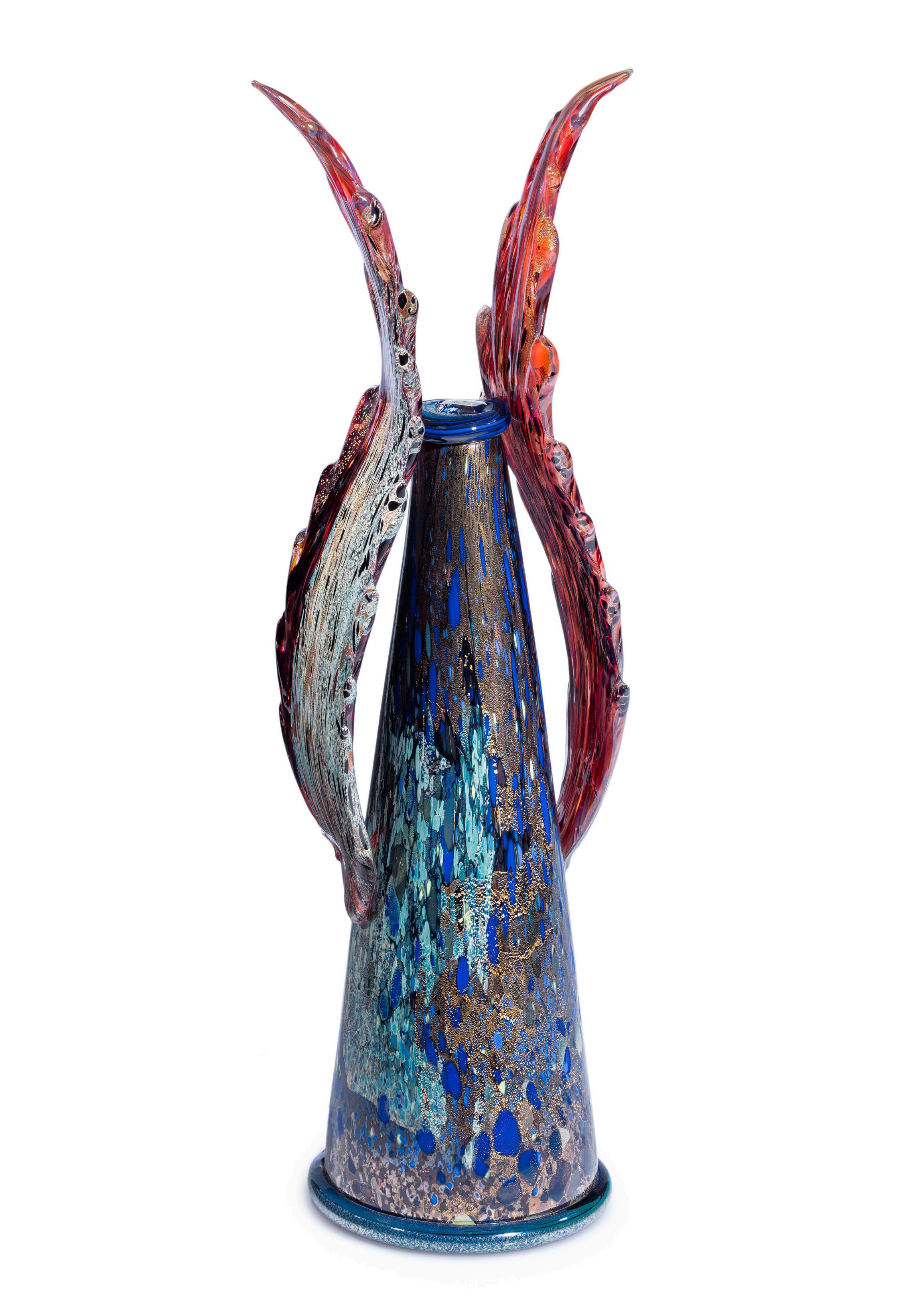
COVER:
LAPIS AND GOLD VENETIAN WITH RED AND GOLD LEAVES (DETAIL)
1989 | 23 x 9 x 6"



COVER:
LAPIS AND GOLD VENETIAN WITH RED AND GOLD LEAVES (DETAIL)
1989 | 23 x 9 x 6"
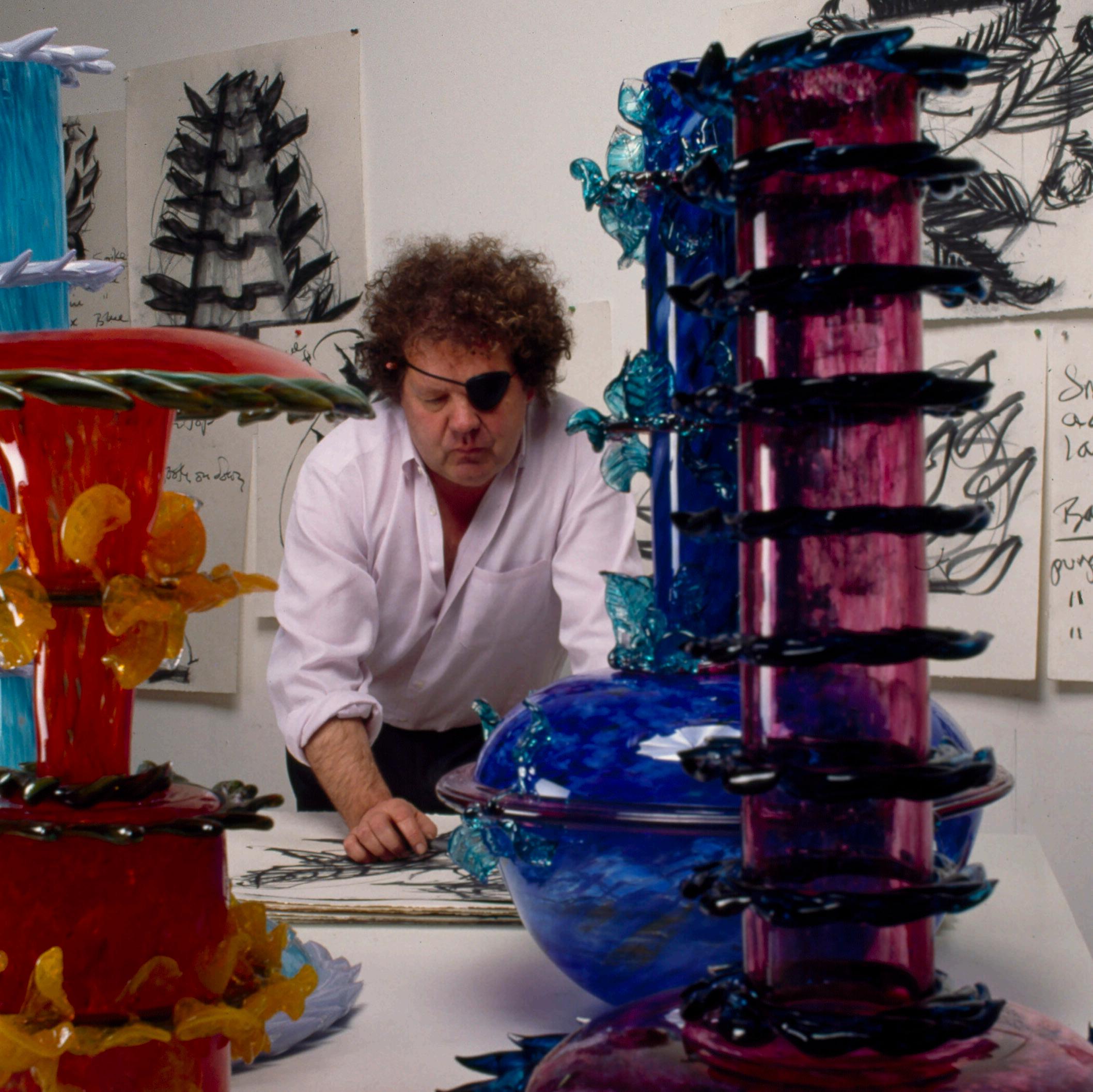
Glassmaking in Venice dates back 1500 years to the Roman Empire, when molded glass was used to allow light into bathhouses and a wealthy merchant class traded precious wares and became patrons of the arts. Laws passed in the late 13th century to prevent a catastrophic fire in the busy metropolis moved glass production to the island of Murano, creating a nucleus of mastery and innovation that continues today. When Dale Chihuly arrived in Murano as a Fulbright Fellow in 1968, he was the first American glassblower to apprentice with the renowned but notably private masters. During his final year of graduate studies at Rhode Island School of Design, Chihuly had written to numerous glass factories but only one glass house responded (the Venetians carefully guarded their techniques so to have any invitation extended was an accomplishment). Founded in 1921 by Paolo Venini and Giacomo Cappellin, Venini Glass Factory was from its inception a house that both honored and challenged the area’s heritage, advanced a high standard of excellence, and embraced the avant-garde.
DALE CHIHULY
The Boathouse, Seattle, 1989
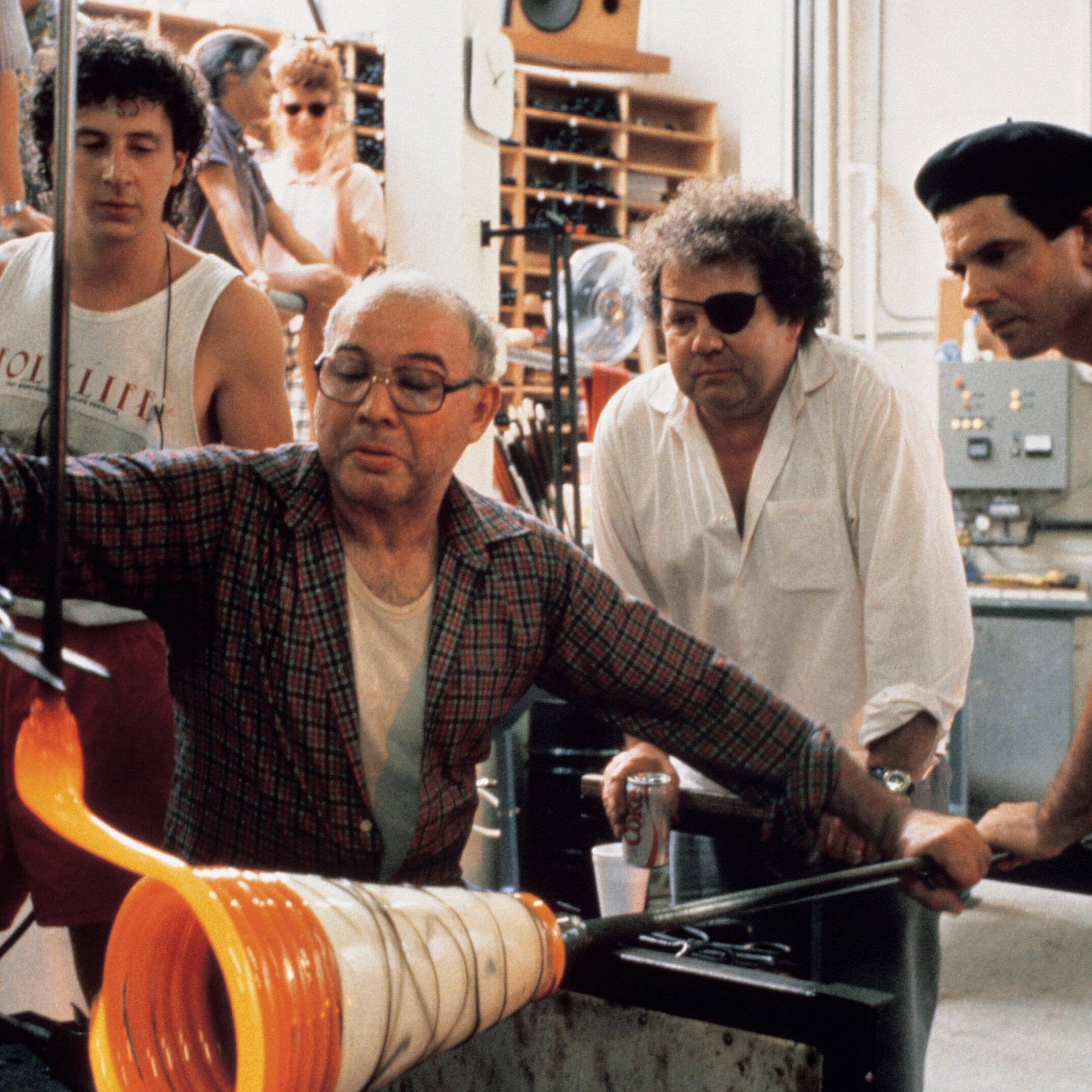
For Chihuly, the year he spent observing and learning from the Italians fundamentally and irrevocably changed his attitudes about glassblowing. Soon after co-founding Pilchuck Glass School in Washington in 1971, he began inviting European glass masters to visit and demonstrate their techniques. One of the first to arrive was Francesco (Checco) Ongaro, from Venini, followed not long after by Ongaro’s brother-in-law, Lino Tagliapietra. The visiting artists would often collaborate with Pilchuck faculty, but as Chihuly explains in his essay for the book on his Venetians, his own work of the1970s was “asymmetrical and very unorthodox,” not appropriate for working in partnership with the Italian masters.
It was not until the summer of 1987, when Tagliapietra visited Chihuly’s first glass studio in Seattle after teaching at Pilchuck, that the idea arose and a plan was put in place for the two to work together the next summer on a series of pieces designed by Chihuly. In the intervening winter on a visit to Venice, Chihuly was inspired by his viewing of a private collection of peculiar Venetian Art Deco vases unlike any he had seen before—classical shapes adorned with surprising appendages and unique handles, executed in vivid colors.
The Austrian composer and conductor Gustav Mahler once said that “Tradition is not the worship of ashes, but the preservation of fire.” The combination of Chihuly and Tagliapietra—equal parts veneration of their forebears, exuberance for the possibilities of the medium, and total openness
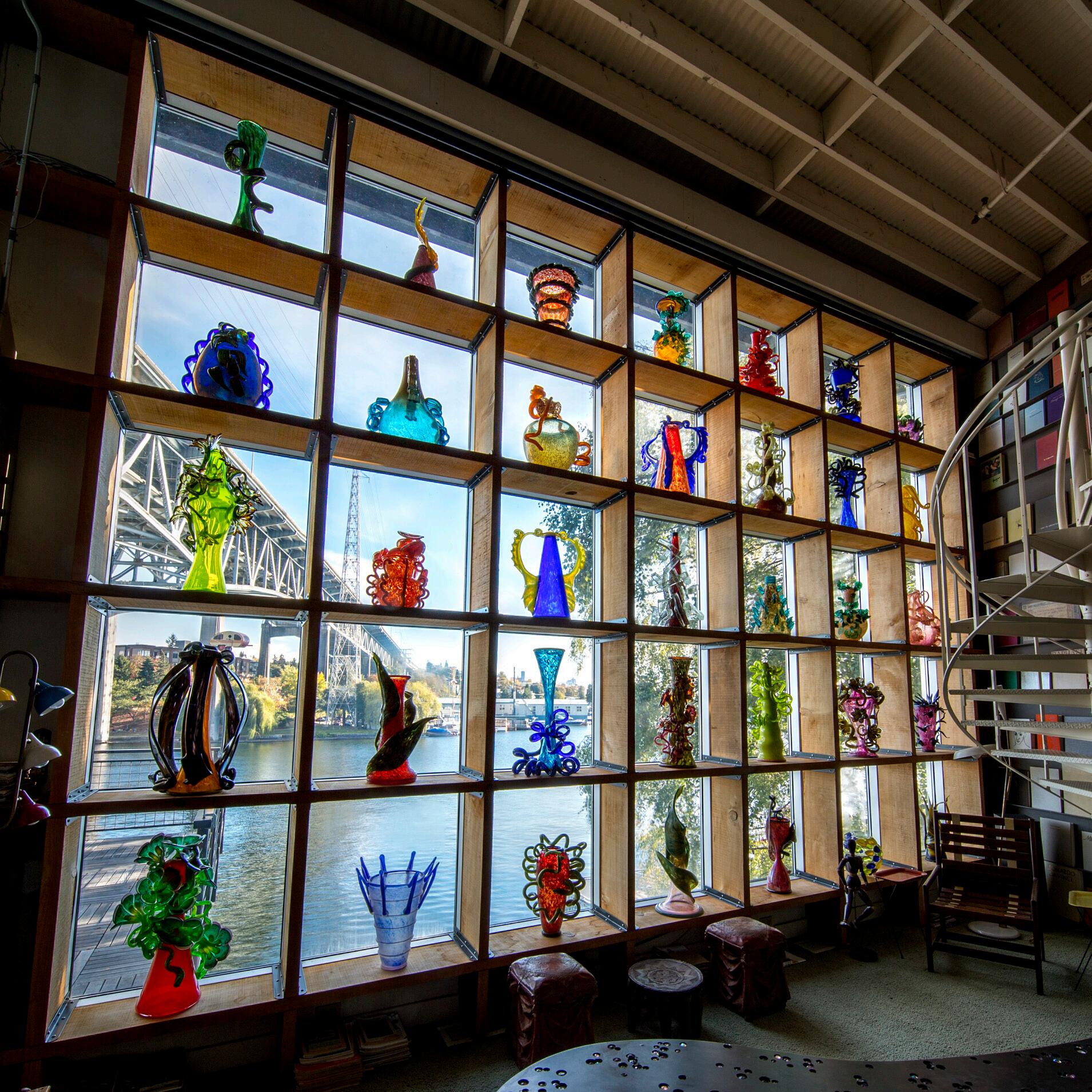
to the other—provided fertile ground for a phoenix of creativity to rise from the ashes of tradition. On an early July morning in 1988, the two met a crew of the best glassblowers in Seattle (including Benjamin Moore) and began to work. The results were quiet at first, Chihuly’s watercolor and pencil drawings of classical Etruscan forms interpreted in glass by Tagliapietra. Quickly, the drawings and resulting glass pieces became more involved. By the fourth day Chihuly was laying bold strokes in charcoal of fantastical and unexpected forms in the drawings which Tagliapietra would then recreate in glass. Chihuly executed the lively and gestural drawings with such visceral enthusiasm that nubs of charcoal would often break in the process and leave ghostly trails of color in their wake. Brash hues, outlandish arms, and motley additions emerged, brought to three-dimensional life by the deft hand of the Italian maestro.
The two worked together on the Venetian series for seven several-week sessions, collaborating later on other series such as the Ikebana. Chihuly says he “…started the Venetians series with the simple idea of replicating these strange Art Deco vases, but I hoped that it would go somewhere else, somewhere bizarre.” For Tagliapietra, meeting Chihuly was “…almost an historic moment…because there was an evolution—an artist vision of glass that was completely—almost revolutionary.” The sumptuous and outlandish works of art in glass that have resulted from their collaboration are a creative and technical tour-de-force exploding with life.
TRANSLUCENT GILDED SIENNA VENETIAN WITH MAGENTA COILS
1991 | 24 x 20 x 16"
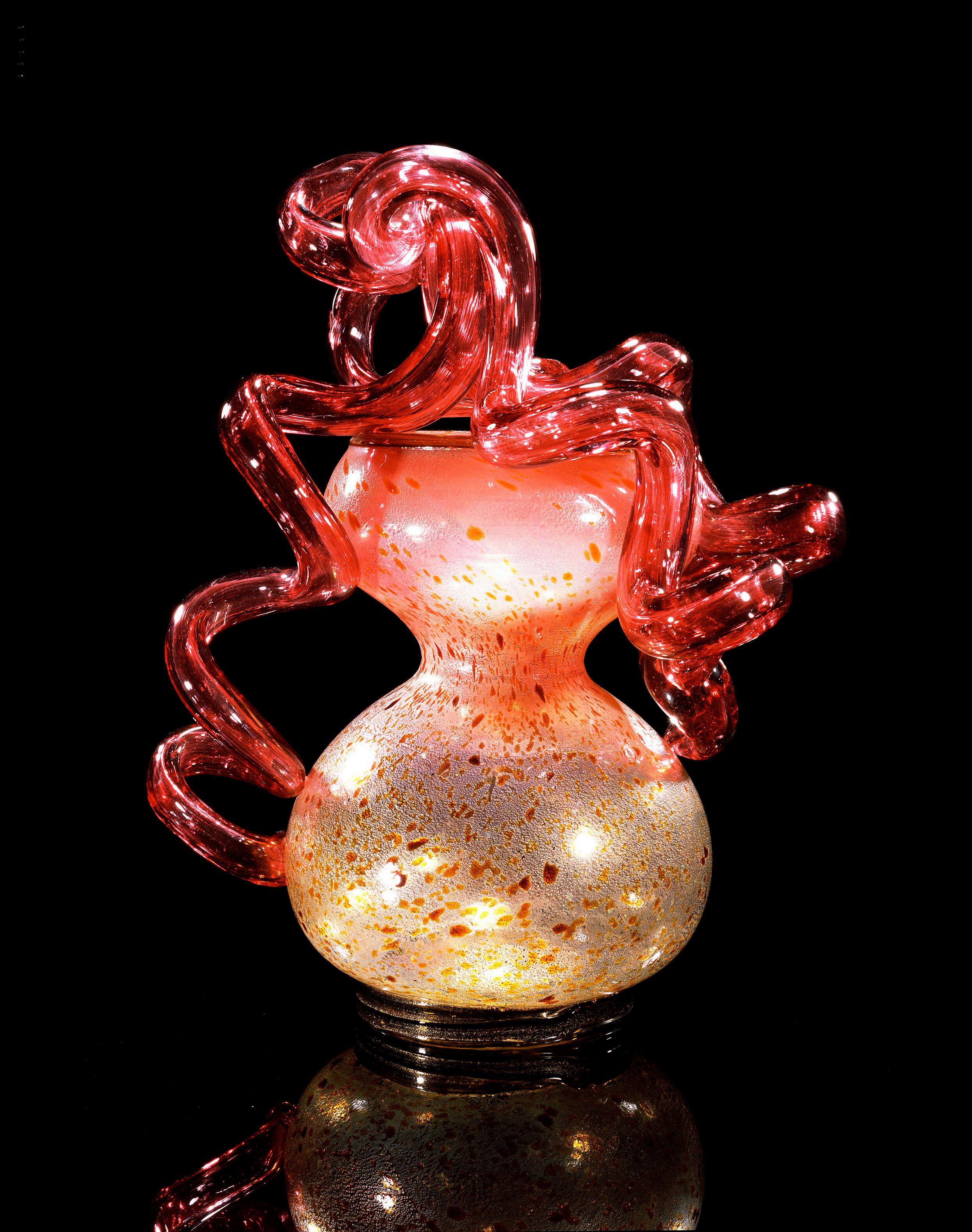
A pompadour of colored glass gives way to curly tendrils cascading down an hourglass form in Translucent Gilded Sienna Venetian with Magenta Coils. Light bounces within the body of the vessel and lands gracefully on the curved surfaces of the coils. An elegant contrast is set up between the bulbous milky golden body and the more transparent magenta curlicues.
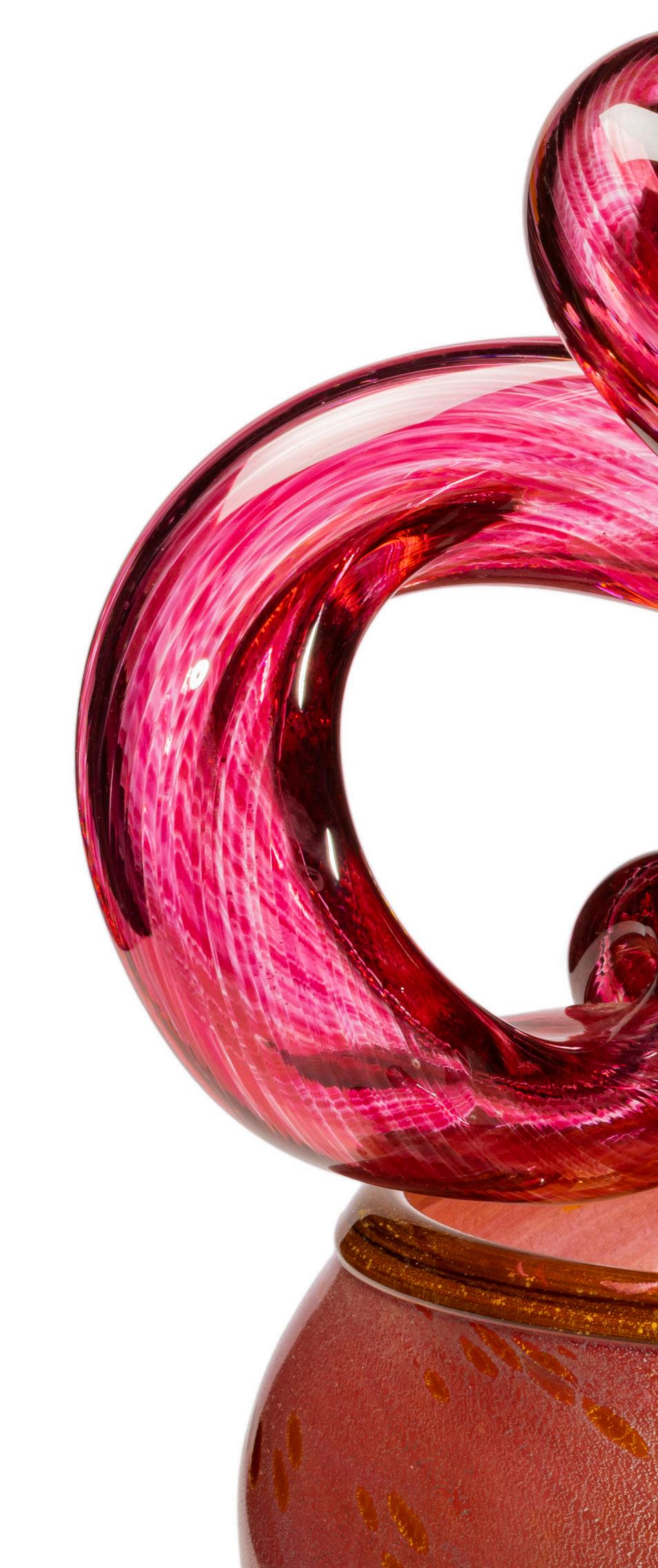
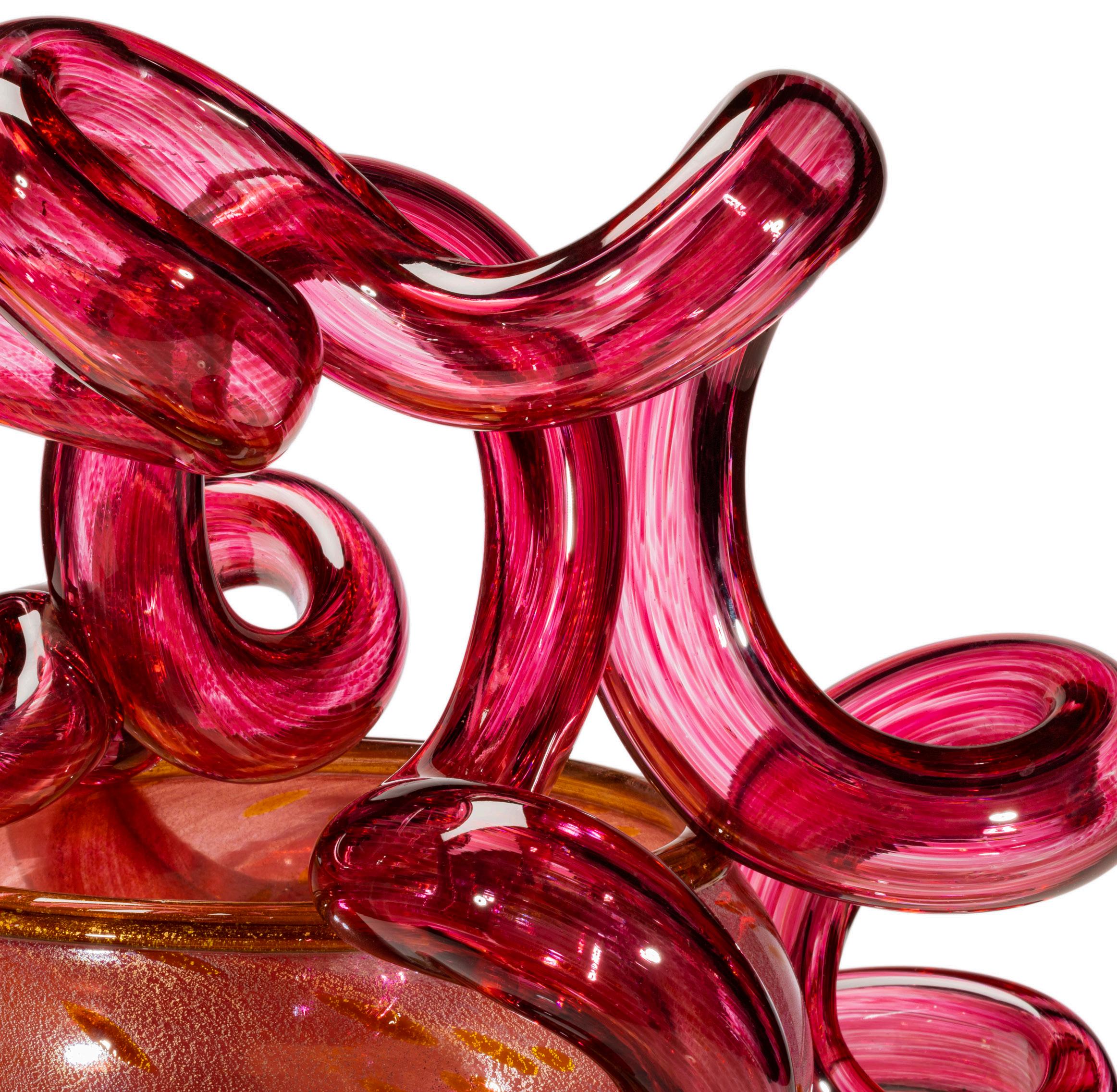
As their name implies, the Piccolo Venetians are smaller examples of the series. Despite its scale, this full-bodied Amber Piccolo Venetian with Abundant Yellow Coils has a commanding presence. The classical nucleus teems with flecks and texture and erupts in a tumult of tightly coiled yellow appendages. From the chaotic mass atop, these coils fall in wavy stripes down the sides of the vessel.
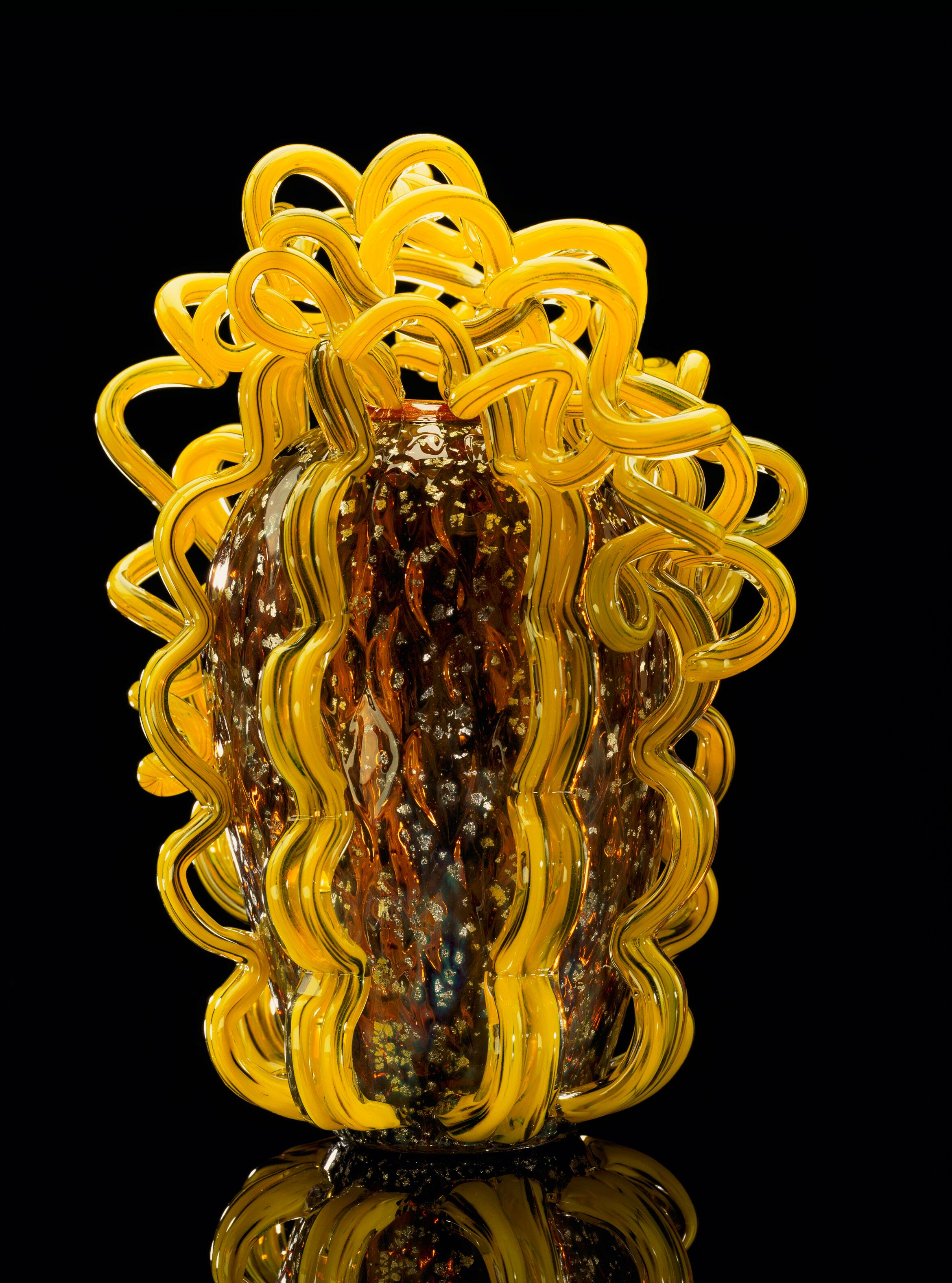
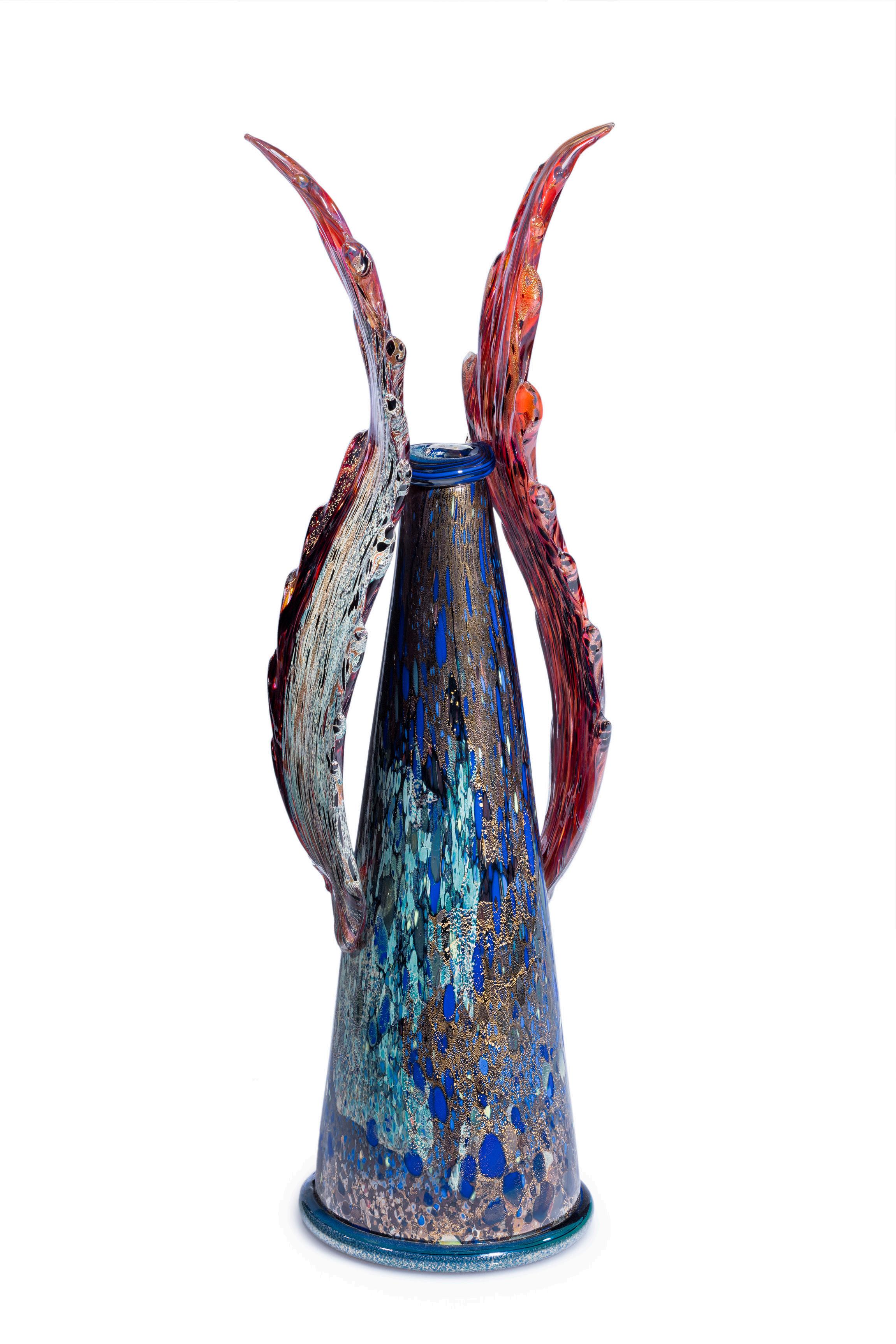
The relatively simple conical base of Lapis and Gold Venetian with Red and Gold
Leaves is animated by the explosive layers of blue and gold in the glass. If the base offers a sense of earth’s profundity, the wing-like arms reaching up like licking flames offer a counterpoint of lightness. Repeated gold tones create unity between the “trunk” and the “leaves” of this metaphorical tree, while contrasting red and blue create tension.
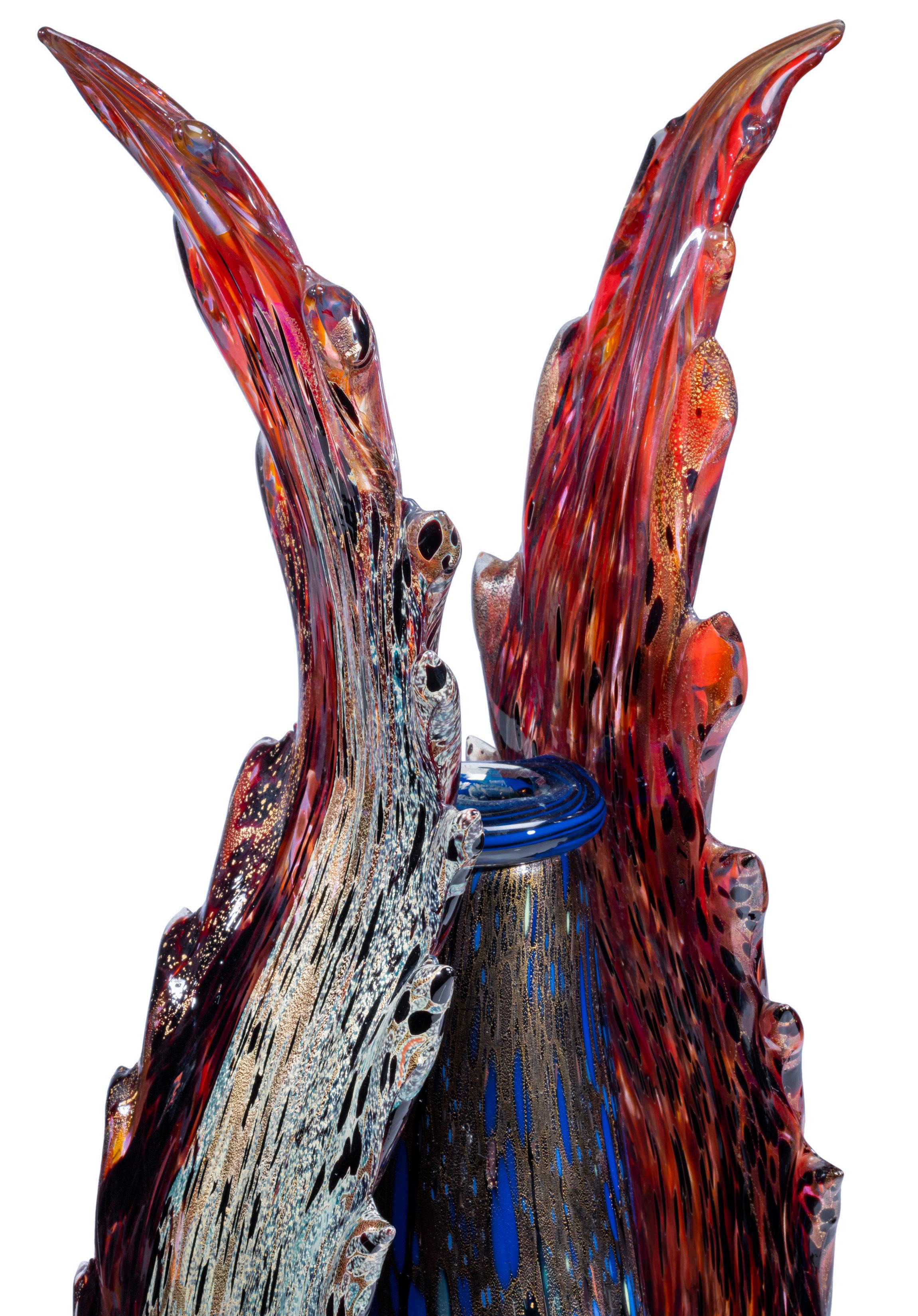
Chihuly’s love of color is as much on display in the title of this work, Sap Green Venetian with Aureolin Feathers, as it is in the work itself. Aureolin is a brilliant, warm yellow pigment used in painting, and the feathery swath of lemony glass in this sculpture sweeps through the air like a dramatic, dimensional brushstroke. The sap green coloration on the glass vessel moves with a similar dynamism as the entire Venetian curves gracefully from its round base to its delicately pointed tip.
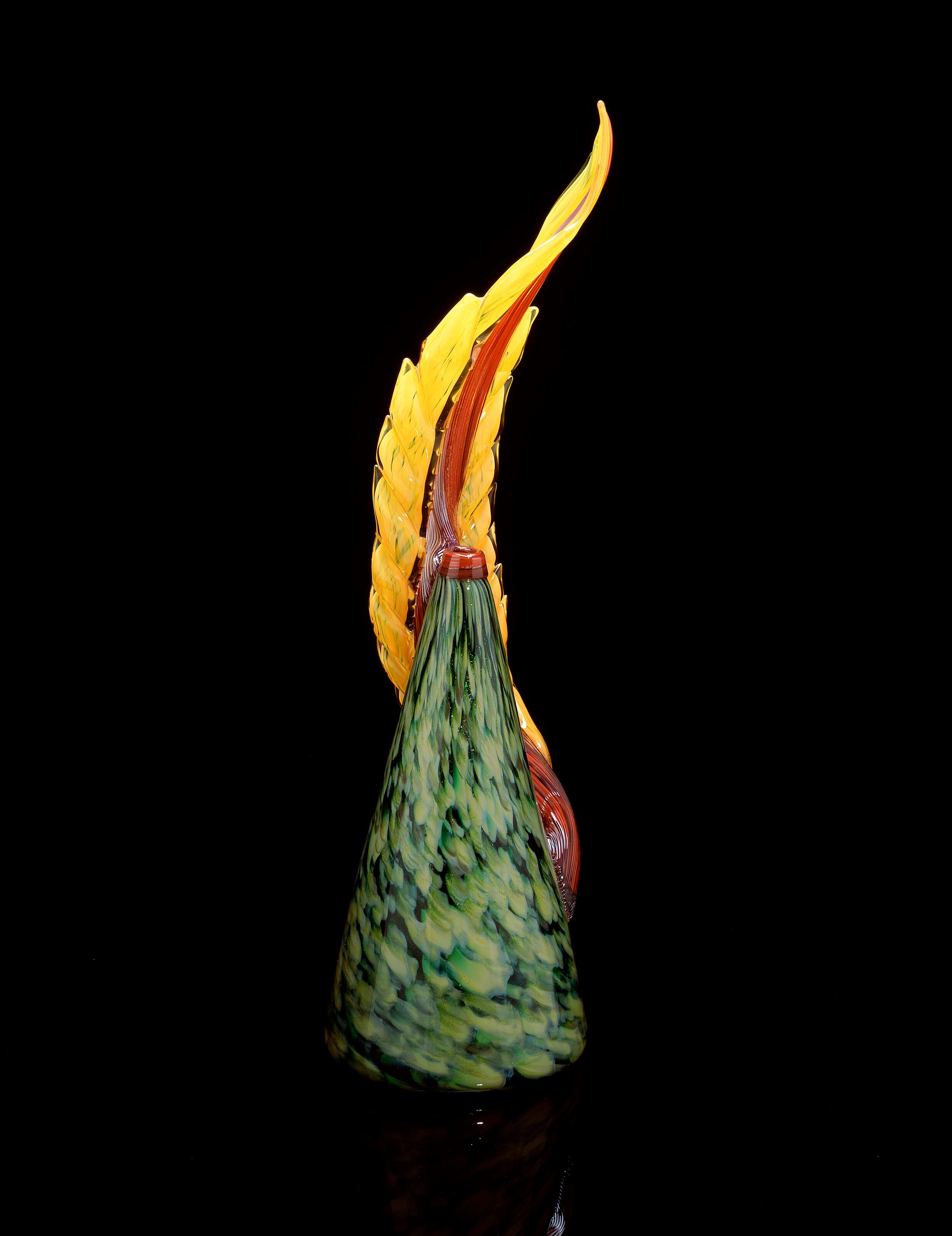
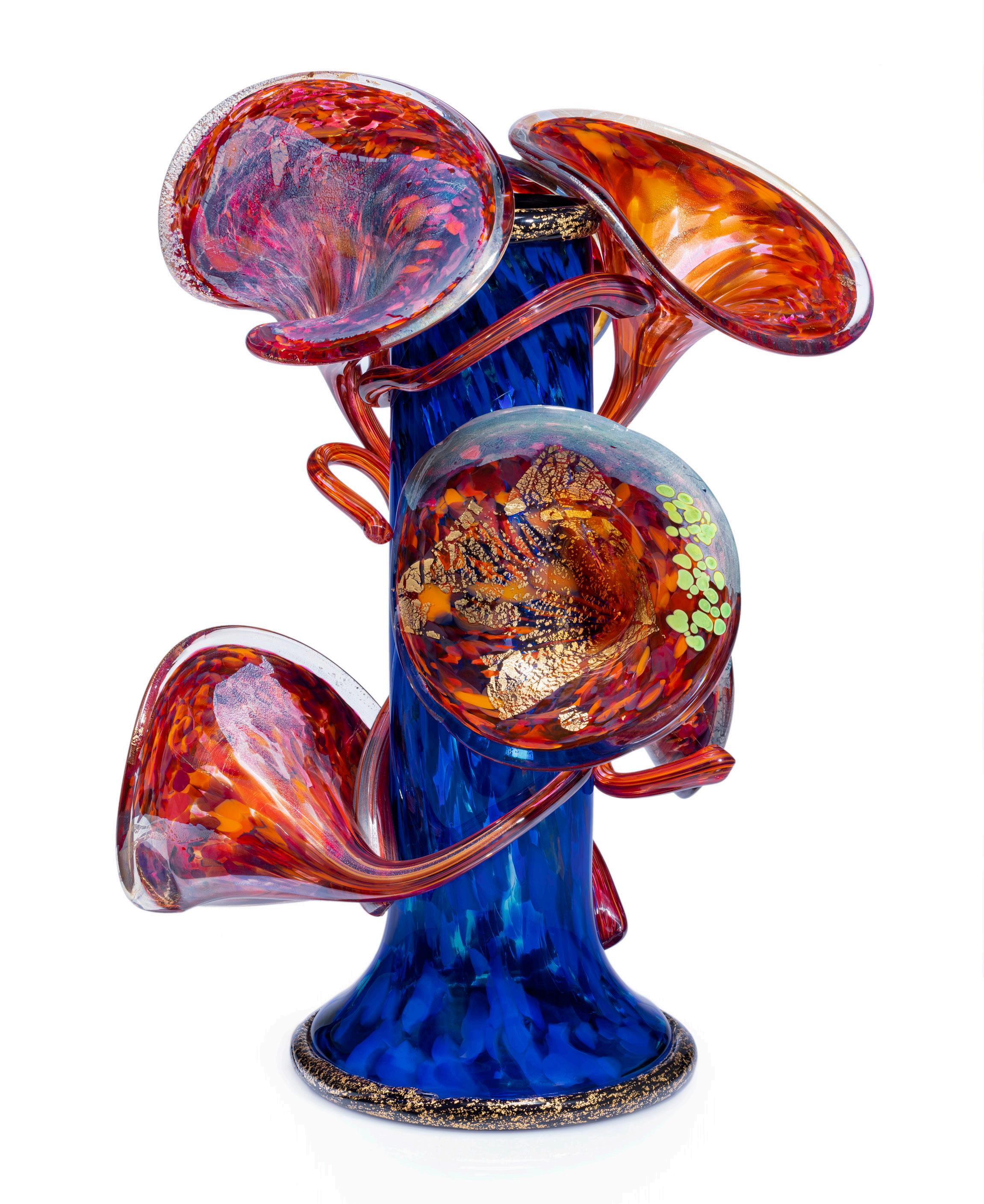
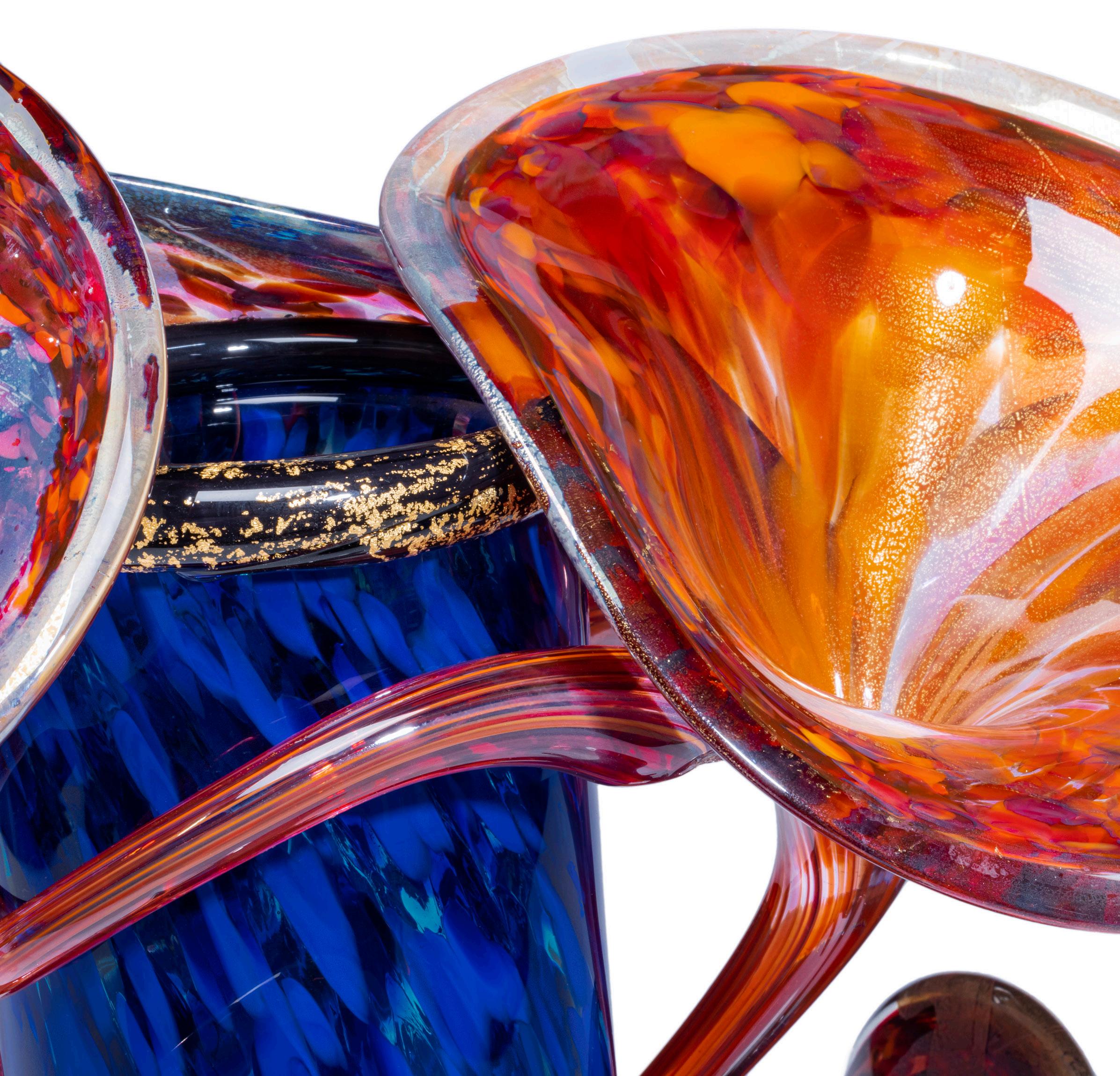
The regal cylinder of the Cobalt Blue Venetian is crowned with a gold-speckled lip (with a similar wrap around its base).
Layers of punctuating blues— ranging from deep night sky to brilliant cerulean— scatter across the surface in an upward motion.
Trumpets of red and orange glass flecked with green and gold serpentine around the body of the vase then bloom like outsized mushrooms.
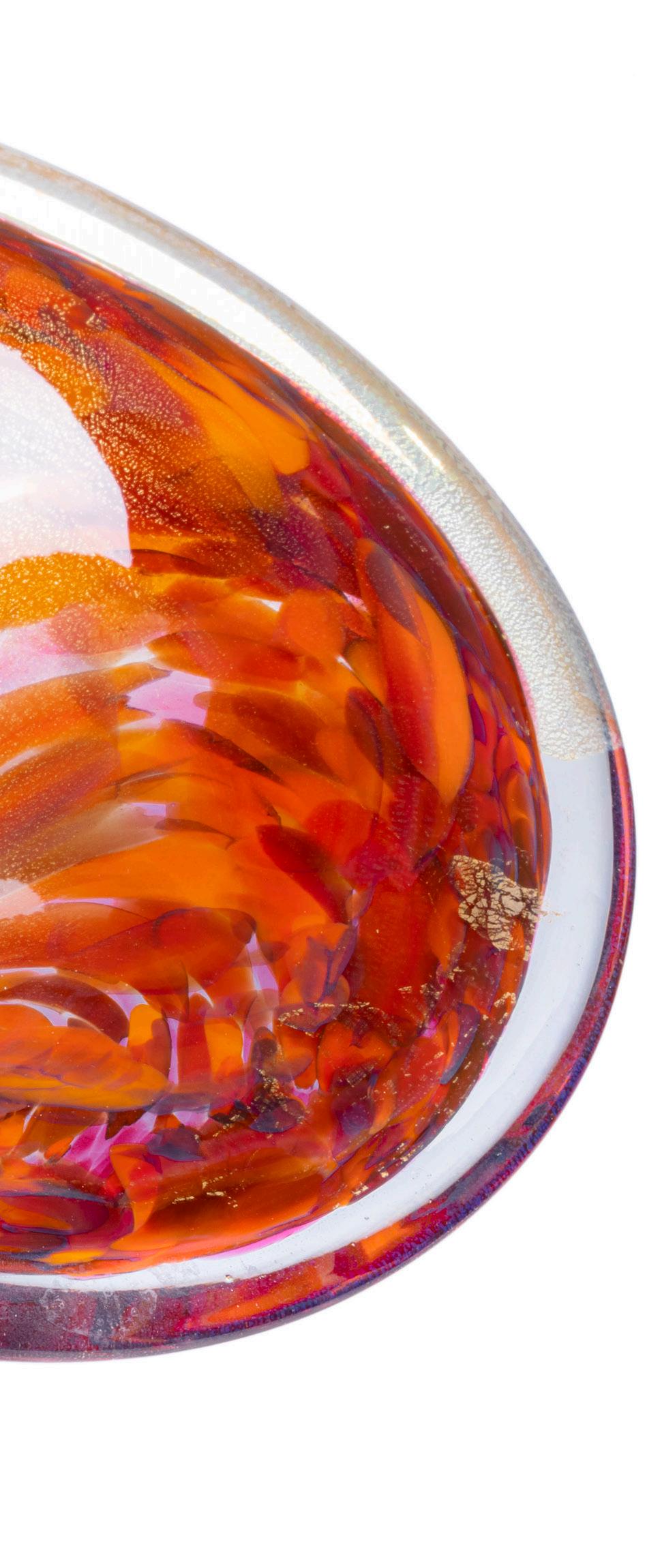
The cantilevered tangerine spirals that wrap their way around the yellow vessel in Aureolin Venetian #185 give the impression of a technicolor glass Guggenheim. The coil is not one continuous and smooth pull of glass but is created from textured and dimensional pieces, with finger-like protuberances and petal-like outcroppings. Drama builds in this gravitydefying sculpture as its narrow base blossoms into its wide mouth which invites the viewer to study both within and outside the glass body.
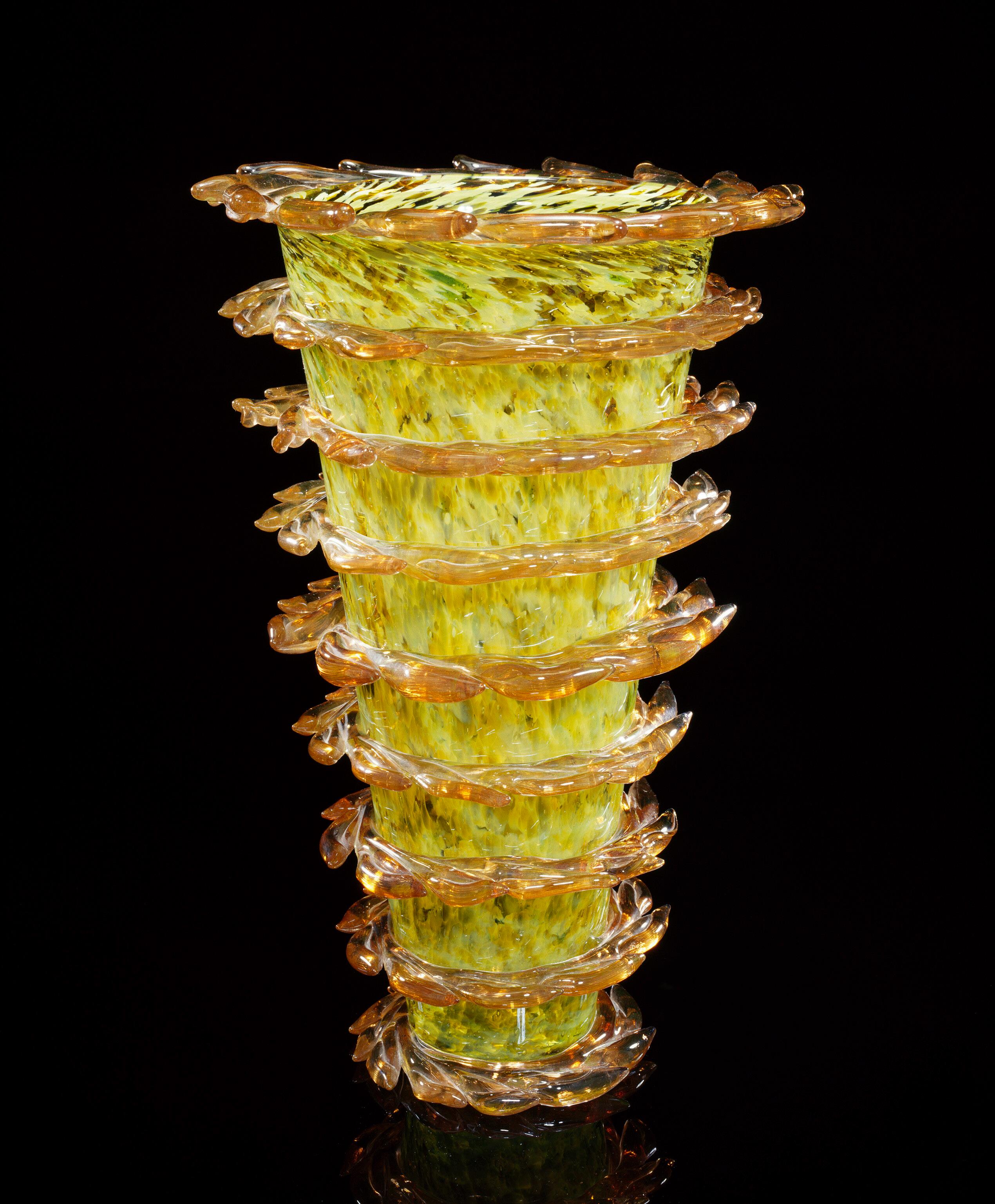

Taken alone, the central vase in Diva Blue and Silver Piccolo Venetian with Red Handles— with its amphora shape and crackle-glaze finish—presents like a nod to classical ceramics.
Four undulating and non-functional “handles”
upend this homage to tradition as they tightly slither their way from the mouth to the base of the vase. A satisfying visual cacophony exists between the blue/silver section and the red/gold of the arms, the varying hues reflecting off and absorbing each other.

Silvered Transparent Blue Venetian is an early example of the series dating from 1988, when the forms were straightforward, the colors muted, and the appendages modest. The lustrous yet transparent surface of the glass creates a canvas of visual interest, bubbling with an internal light and reflecting the external surroundings. Its icy palette of silvery blues lends it a cryogenic feeling, as if the vase has been unearthed from some impossible and imagined Greek glacier.
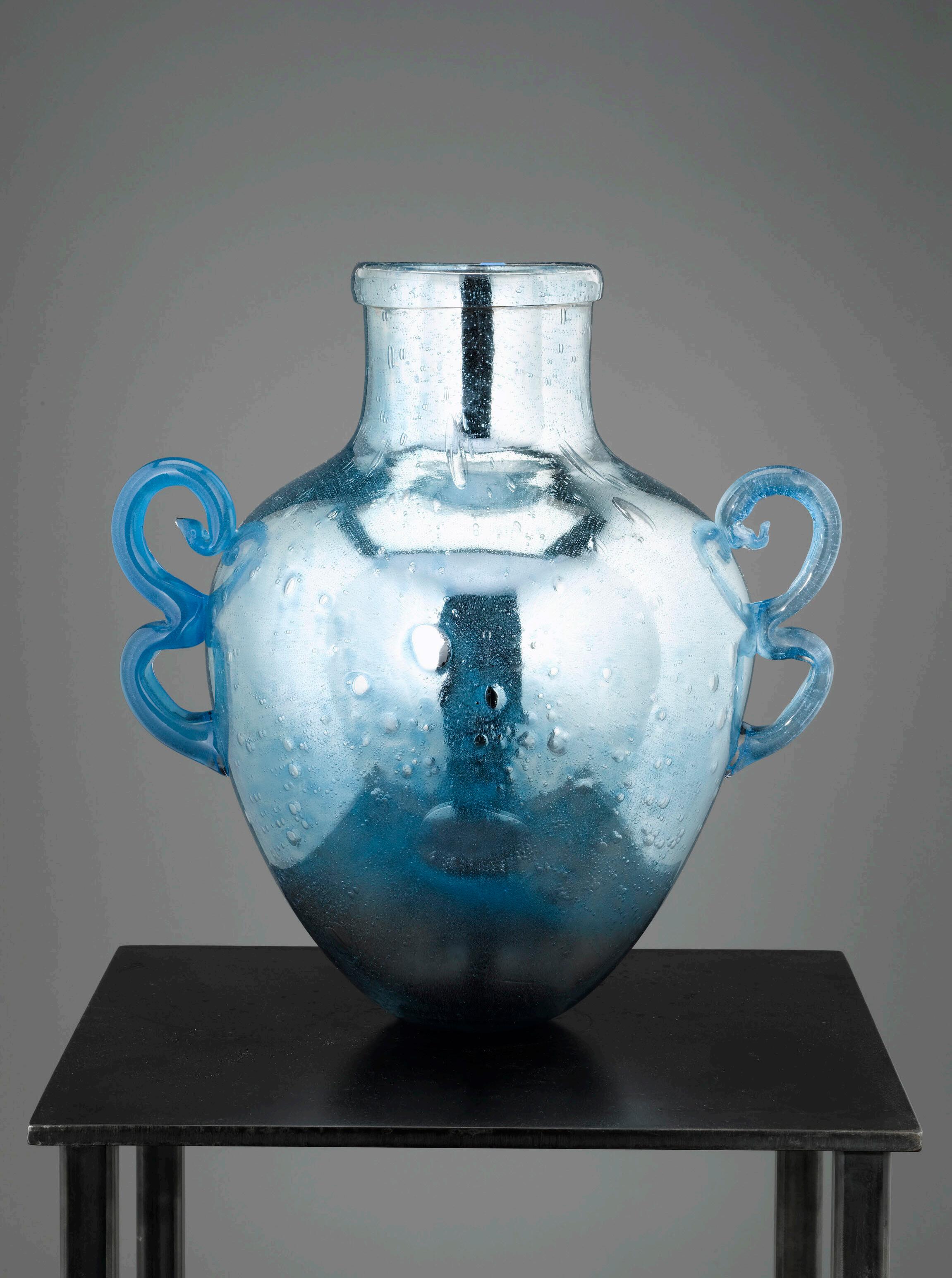
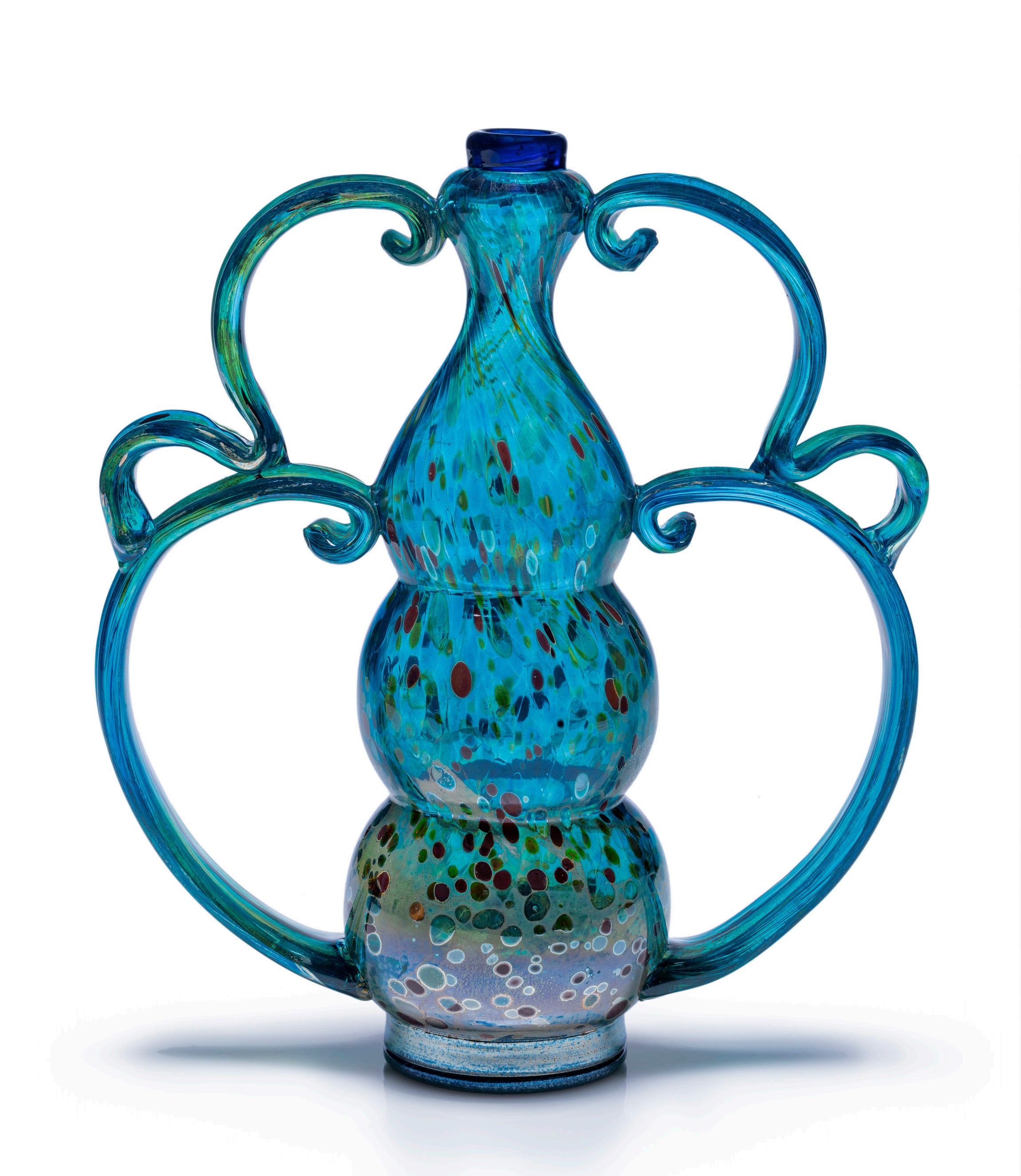
vessel in
Piccolo Venetian feels vaguely Arabian though the title of the work conjures the exotic depths of the ocean. Two sets of decorative curlicued arms emerge from the rocky ocean floor, stretching far out to the sides like stylized blue algae swimming their way to the clear blue surface.
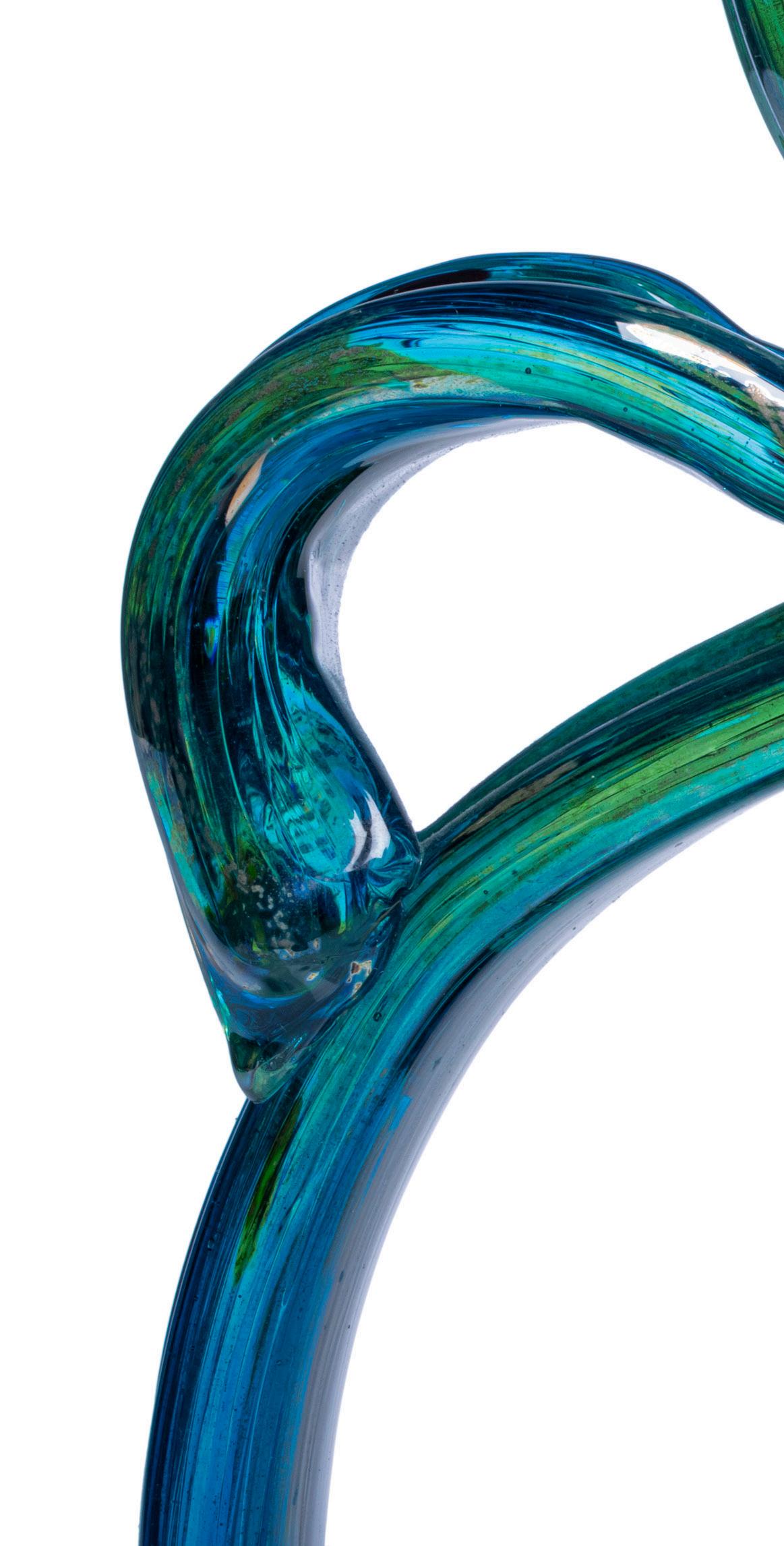

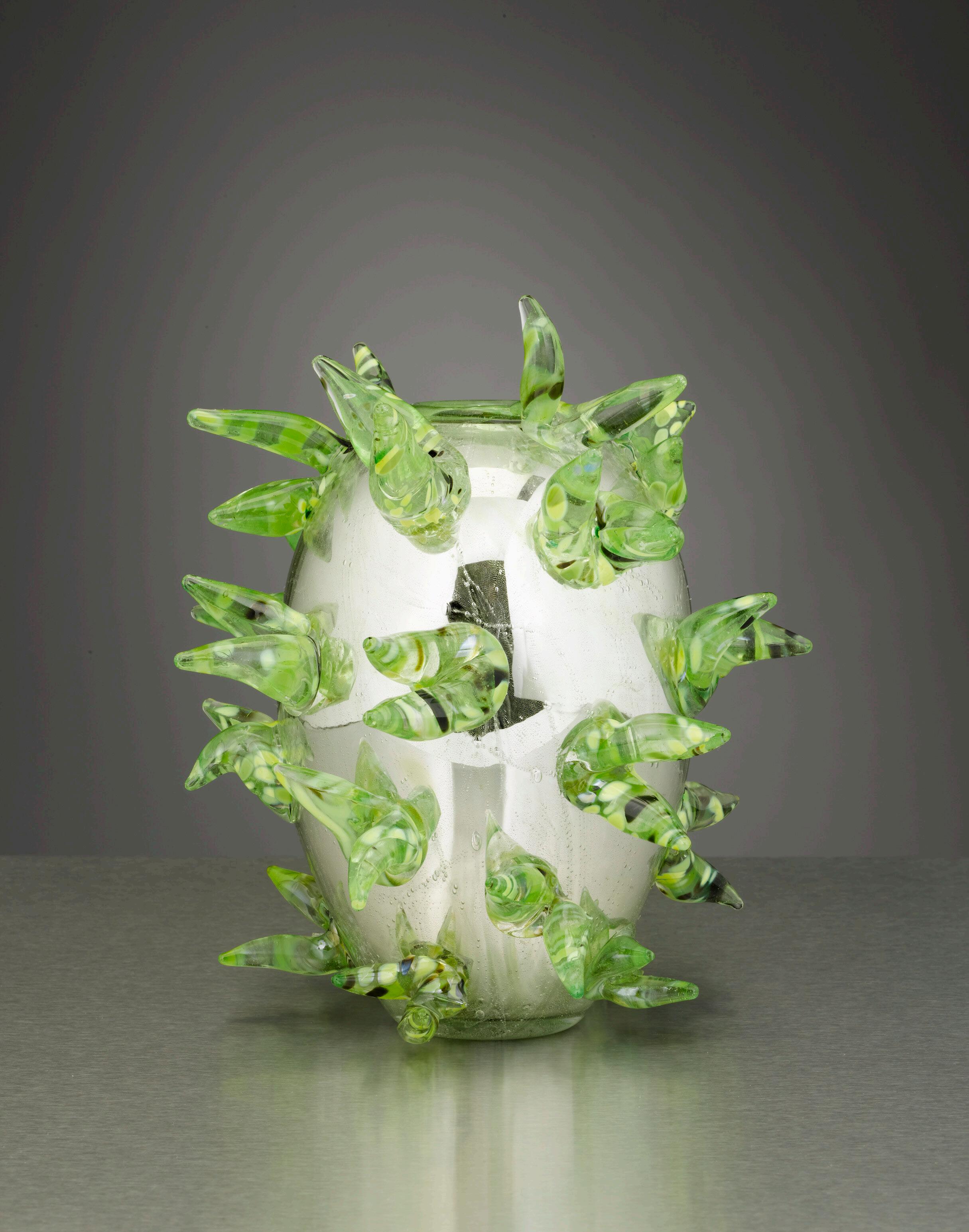
Blue Venetian (1988), Silvered Clear Piccolo Venetian with Lime Green
Spotted Prunts uses reflection to create depth. Horny green amoebas are mirrored on the surface, creating the impression that they are submerged within the glass instead of affixed to it. The green is not a single color but a spotted amalgam of hues that feels biological. The fact that the prunts cover the whole vase feels subversively threatening; were one to want to pick up the vase, one would be hard-pressed to find a safe place to find purchase.

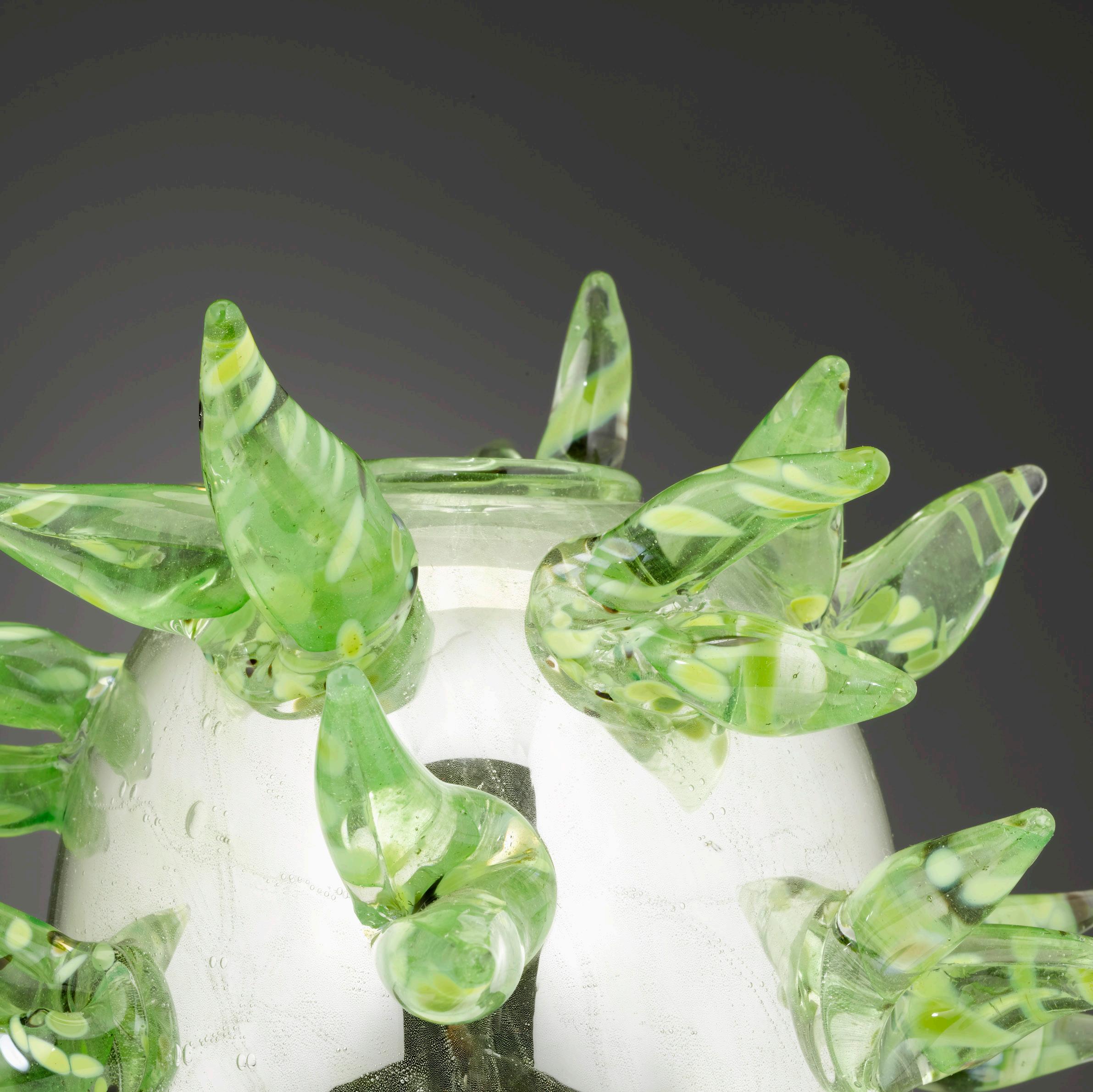
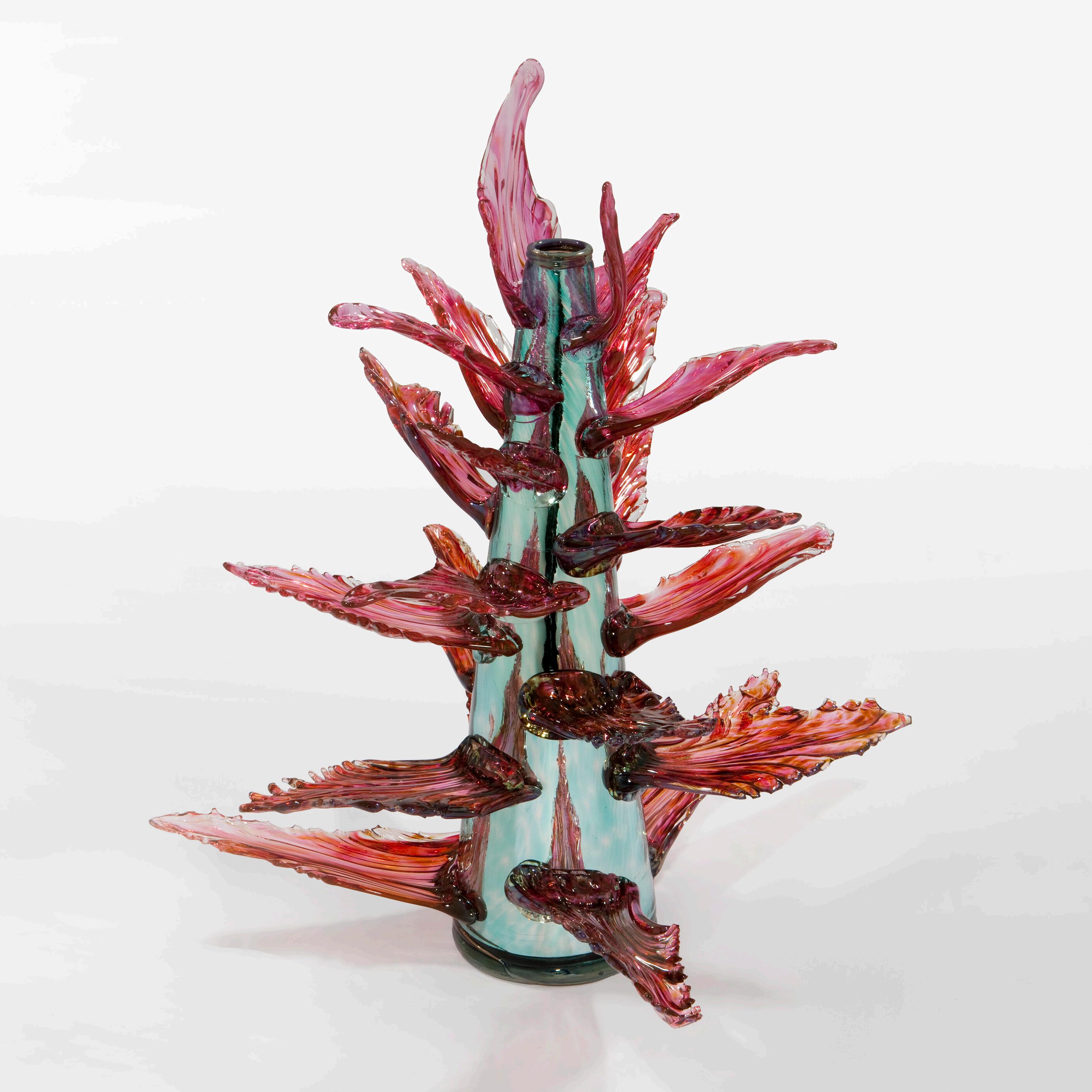
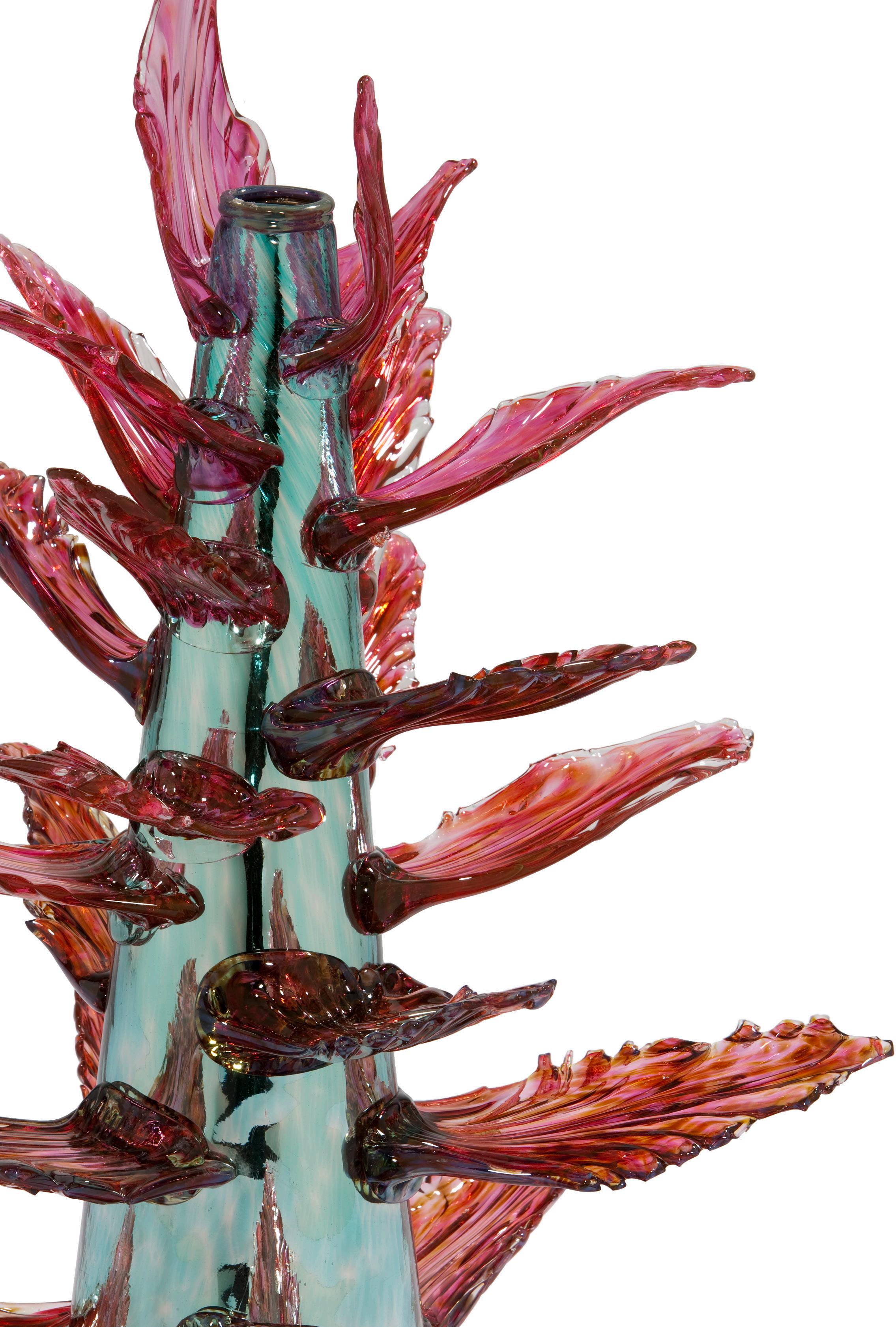
Silvered Lagoon Blue Venetian with Garnet Leaves turns a simple blown form into a fantastical and stylized cerulean trunk sprouting a multitude of flaming pink leaves. The gravitydefying outcroppings first melt down the cylindrical body then cantilever out. They are ribbed like angels’ wings with delicate feathered edges, densely packed but lightly reaching skyward. Created in 1989, the work shows how beautifully and organically Chihuly turned the Art Deco vases that inspired the Venetian series into something completely new and unique.
In Pino Blow Venetian Drawing, Chihuly provides distinct direction in a minimum of impassioned gestures and words. Detritus from the the act of drawing litters the paper, such as smeared words where the artist’s hand vigorously swept across the page. Chihuly uses his materials in myriad ways—turning the charcoal from its point to its side, splattering pigments, and laying heavy swaths of black. The title refers to maestro Pino Signoretto, with whom Chihuly worked at the time.
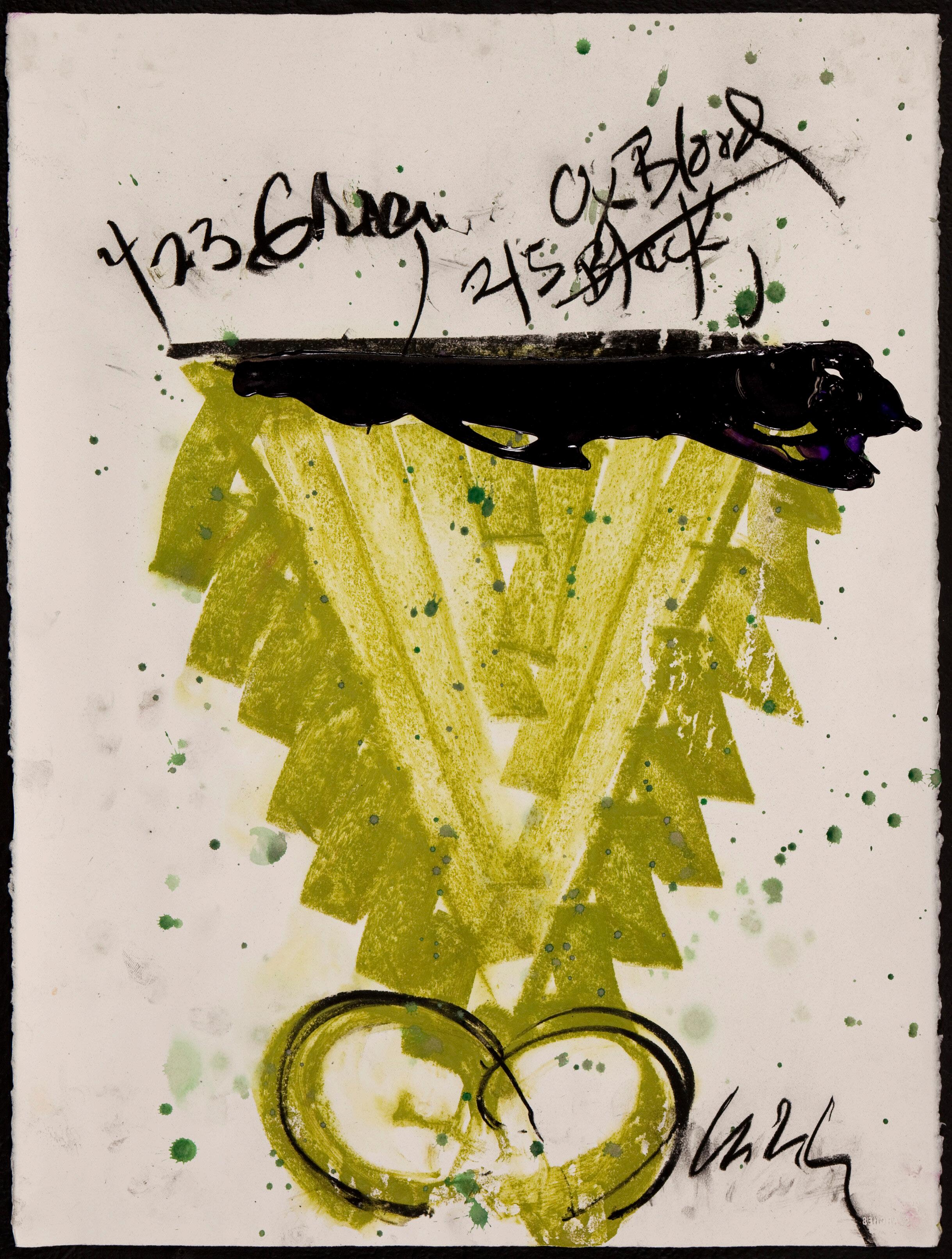
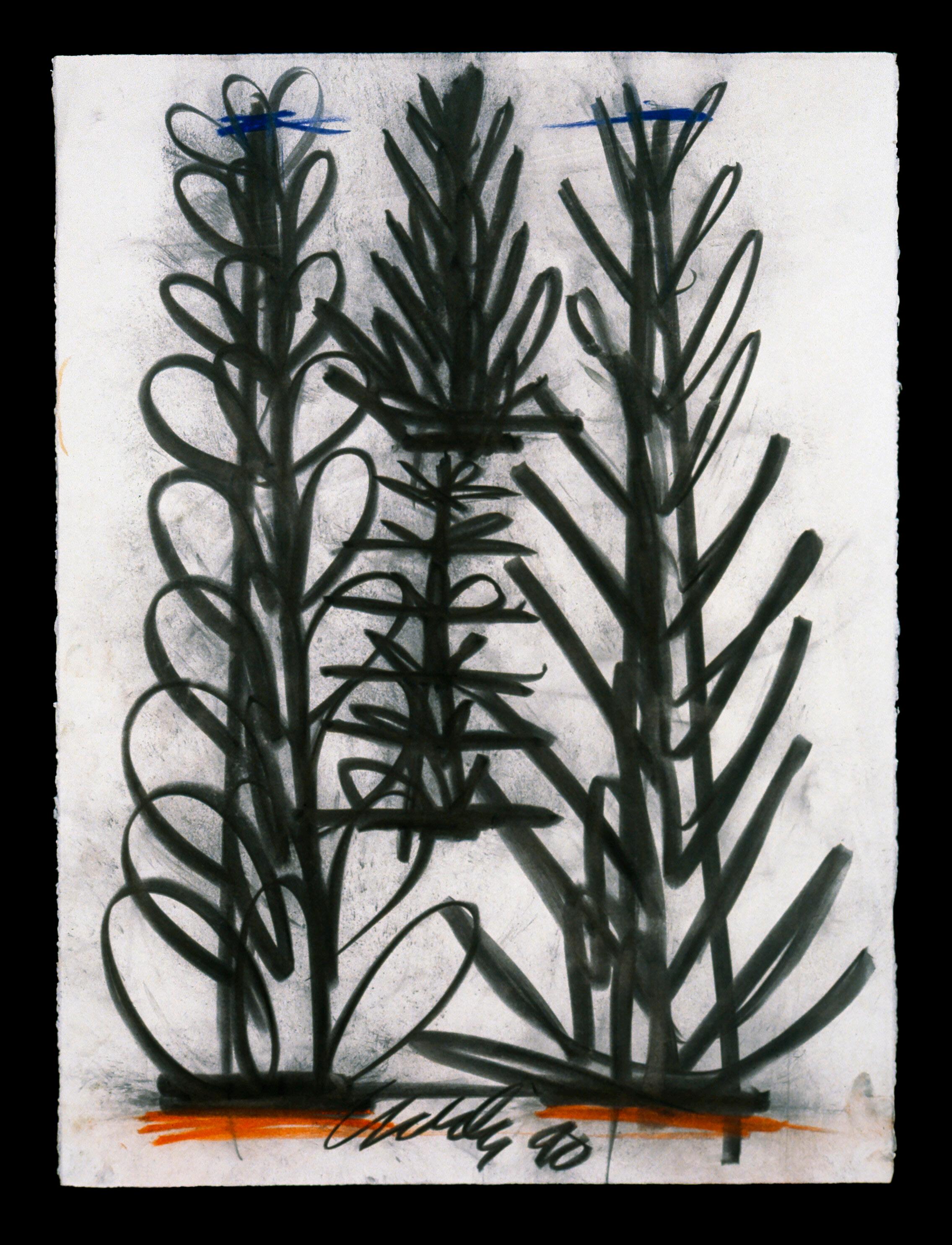
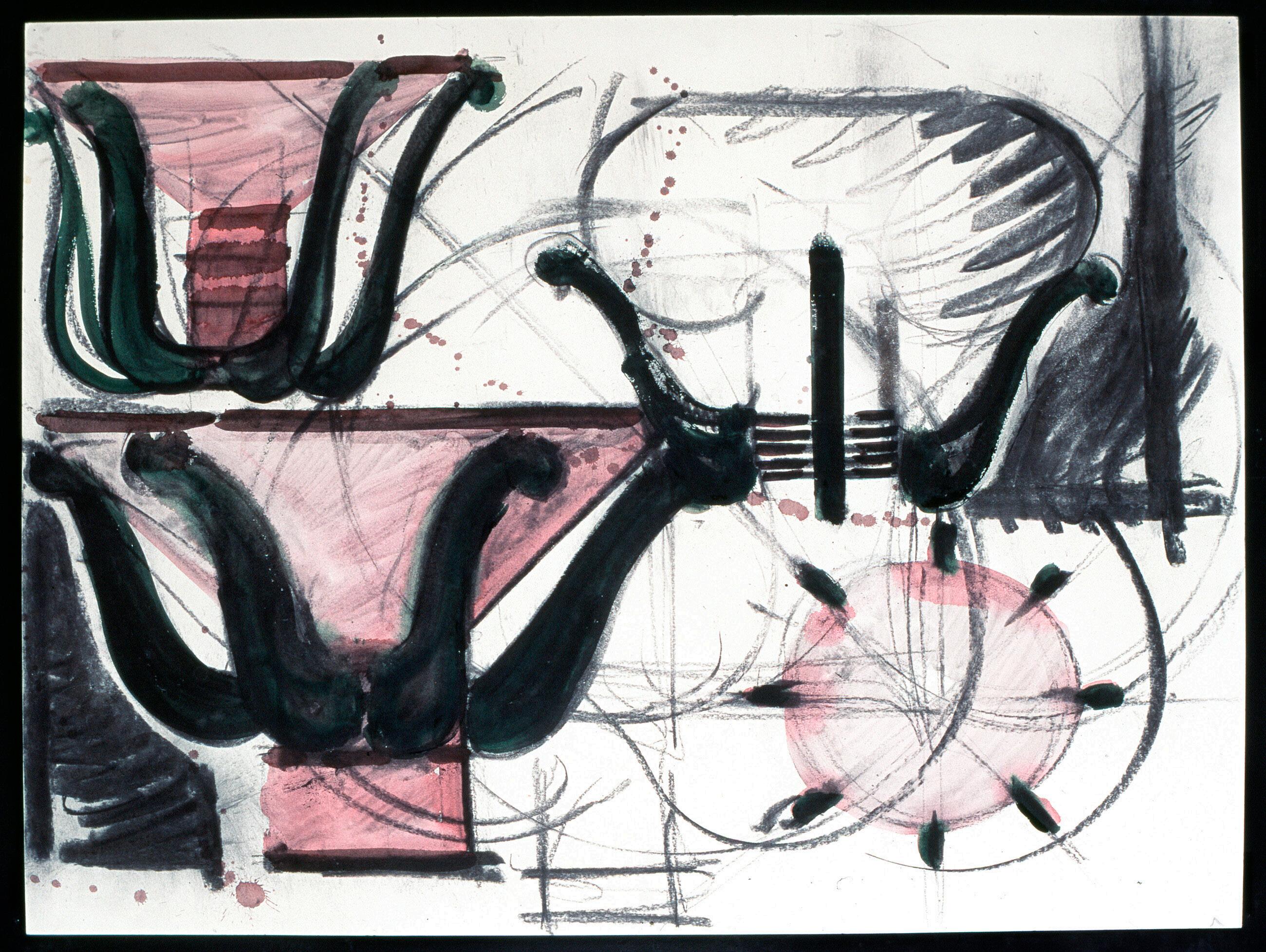
Even when reduced to black ink on white letterhead, Chihuly’s fax sketches teem with life and demonstrate the balance he achieves between planning and spontaneity. There is a clear vision here for the various views of the finished vase but they are viscerally scribbled and open to interpretation.
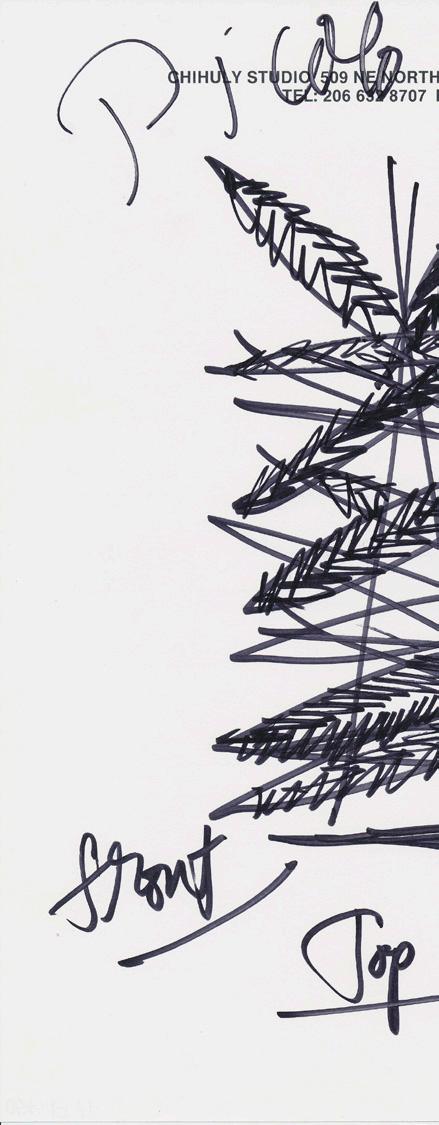
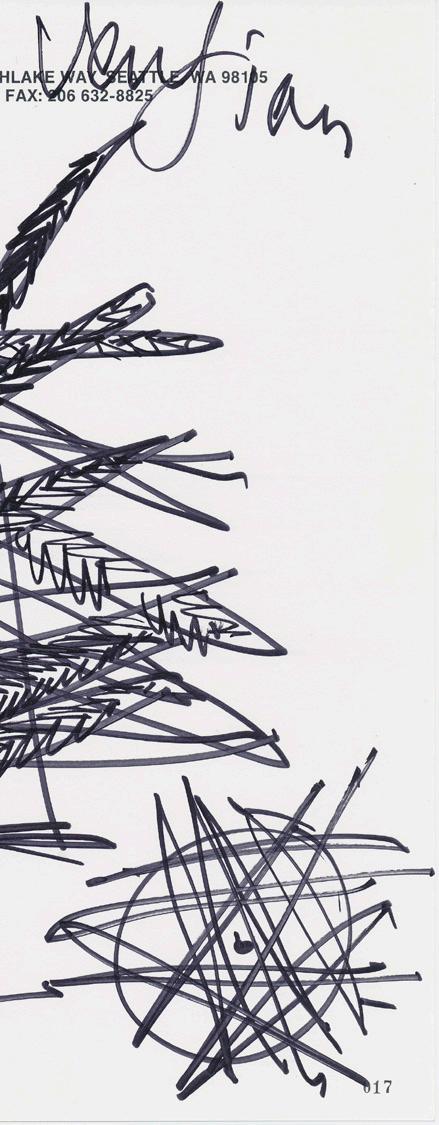
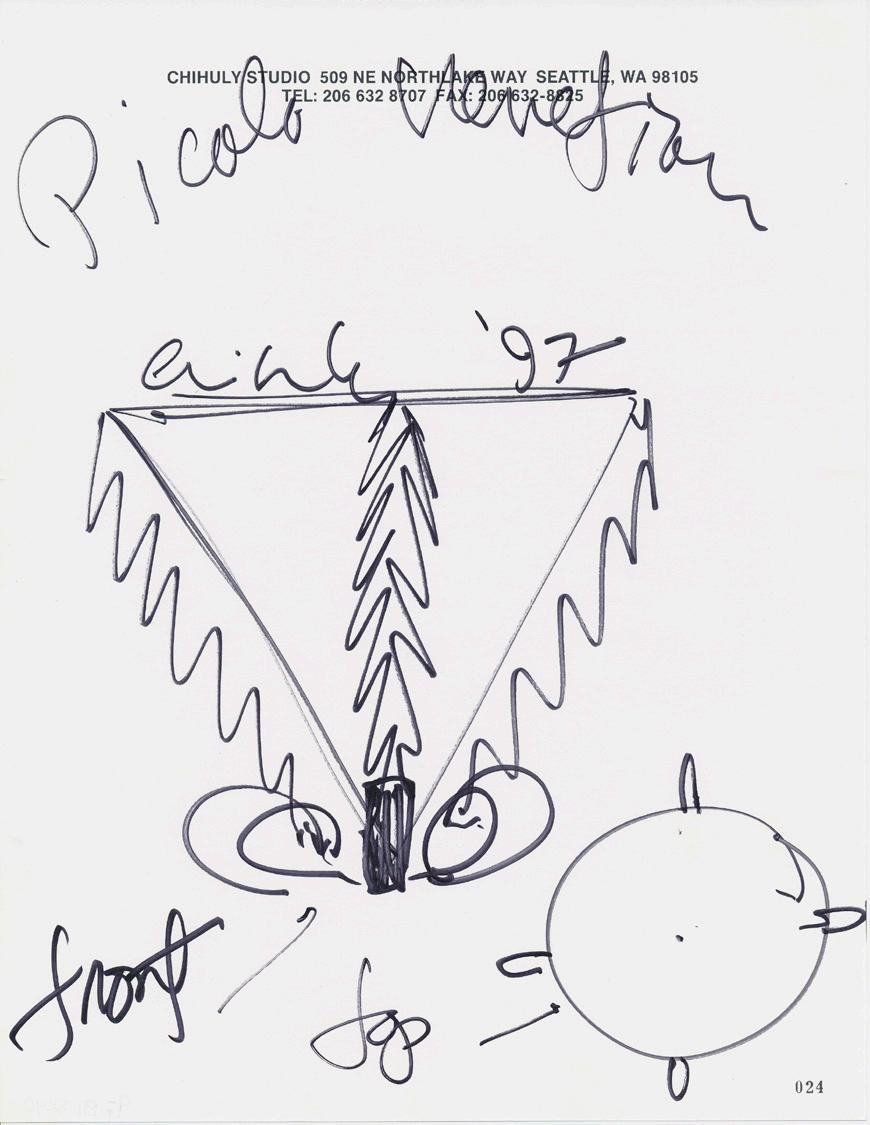
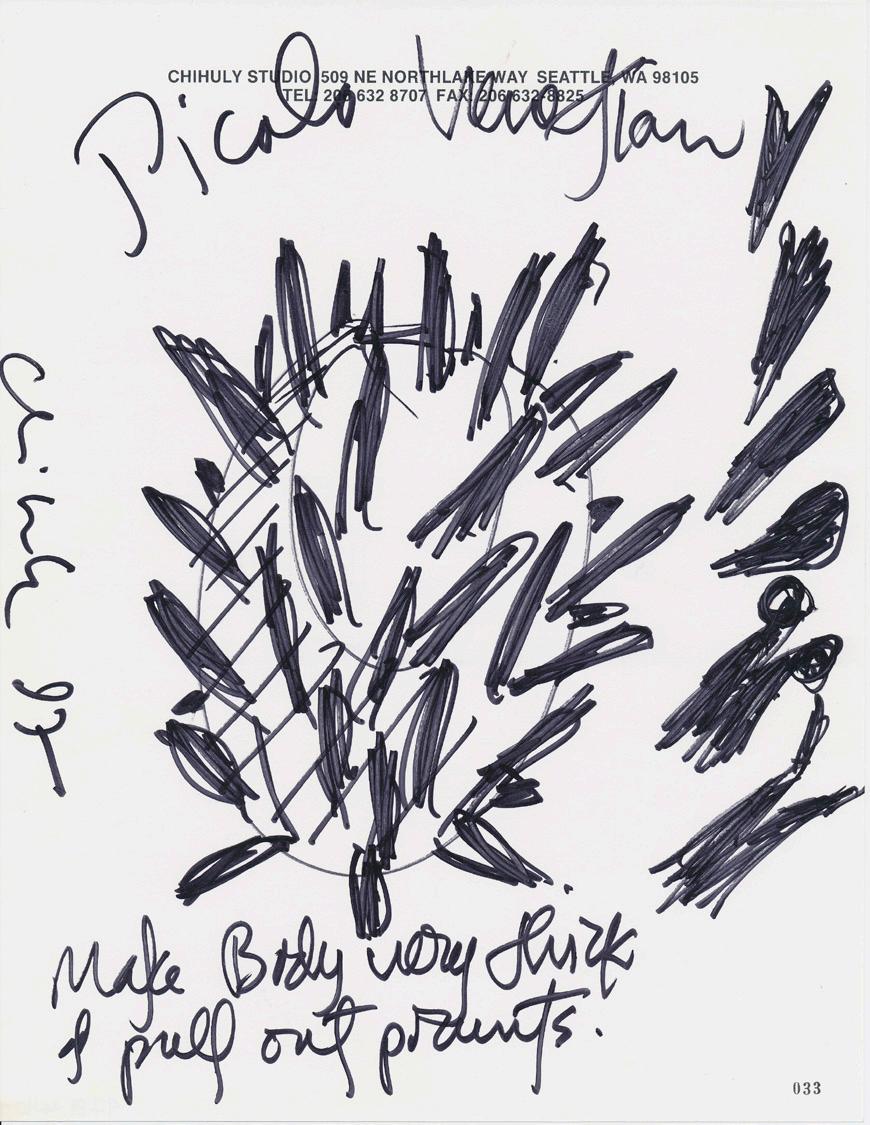
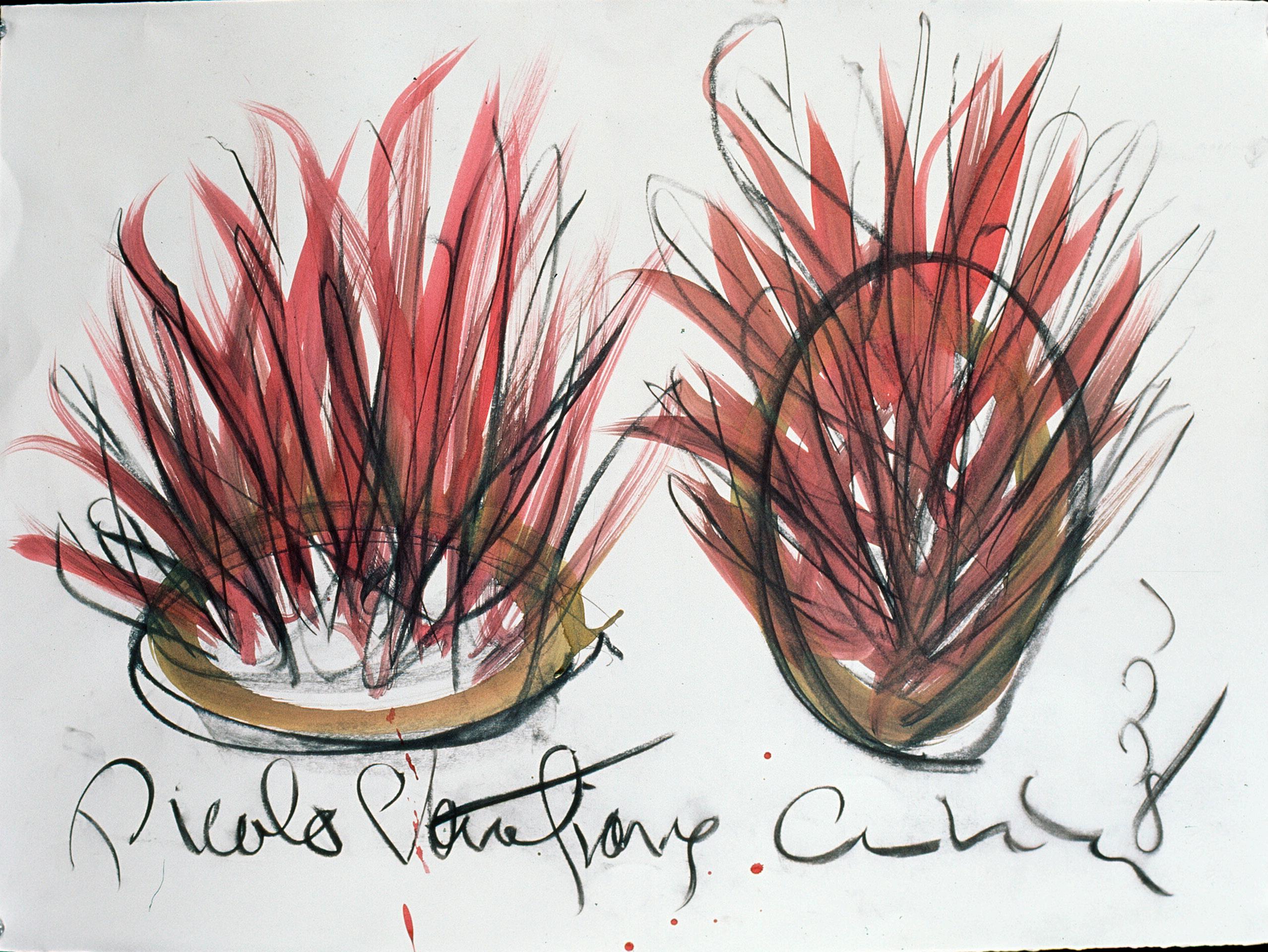
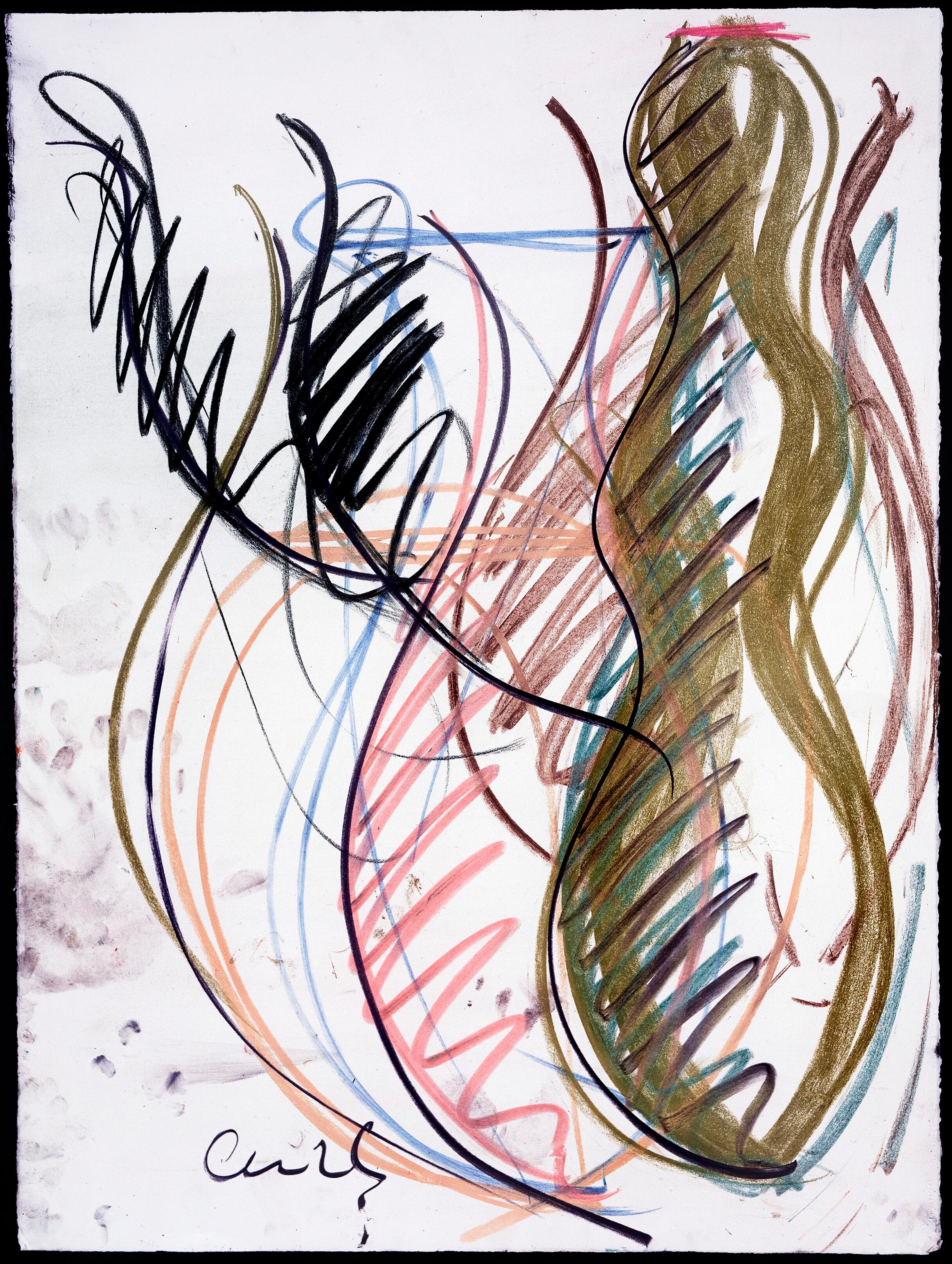
This furious work expresses in two dimensions
Chihuly’s thoughts on the form, tone, and coiled elements that the glassblowers will then interpret in glass. Heavy black underpaint bleeds into a pink aurora background, all covered with a frenzied layering of squirt bottle waves and circles.
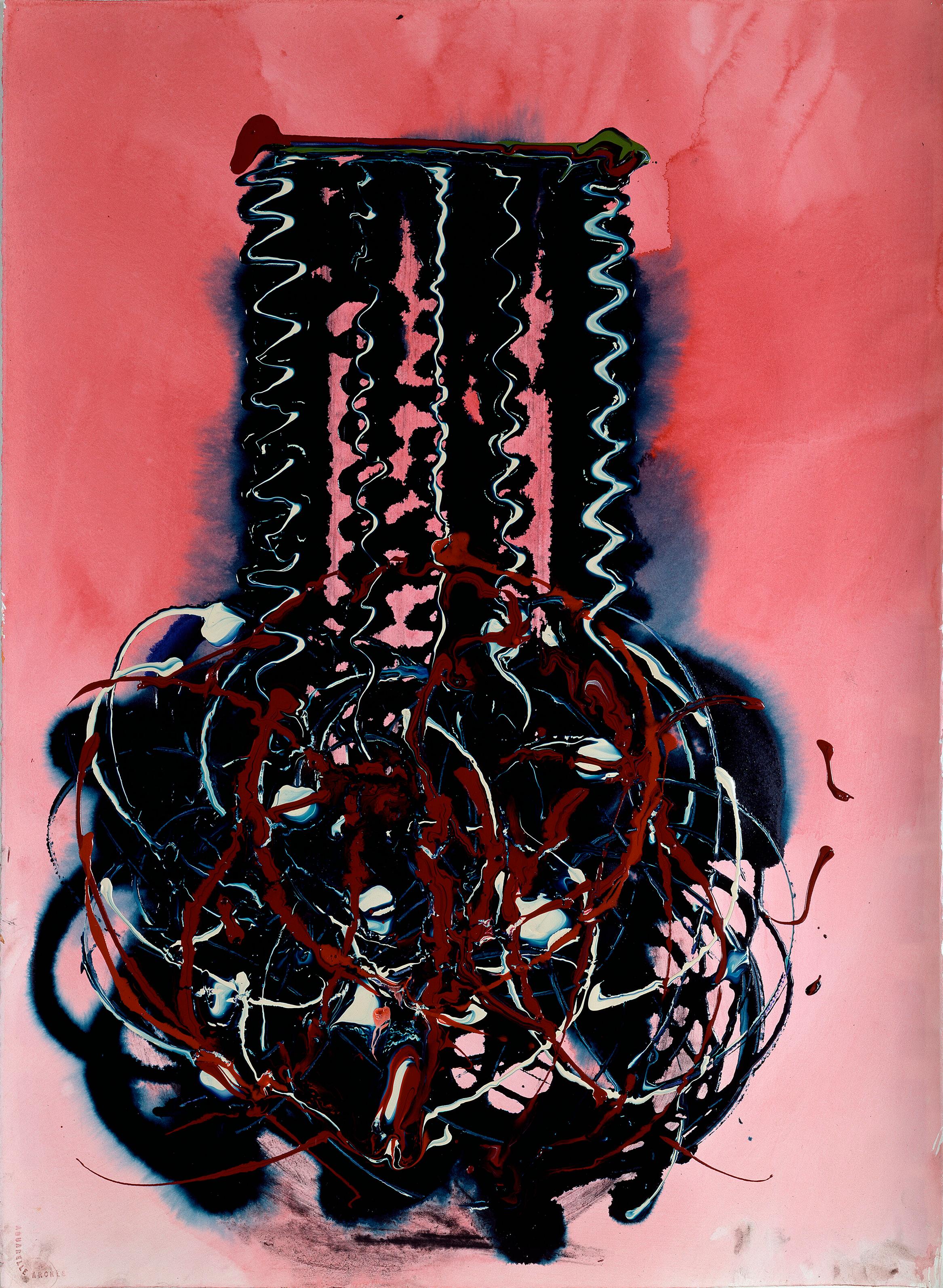
VENETIAN DRAWING
1991 | 30 x 22"
“I started the Venetian series with the simple idea of replicating these strange Art Deco vases, but I hoped that it would go somewhere else, somewhere bizarre.”
–CHIHULY
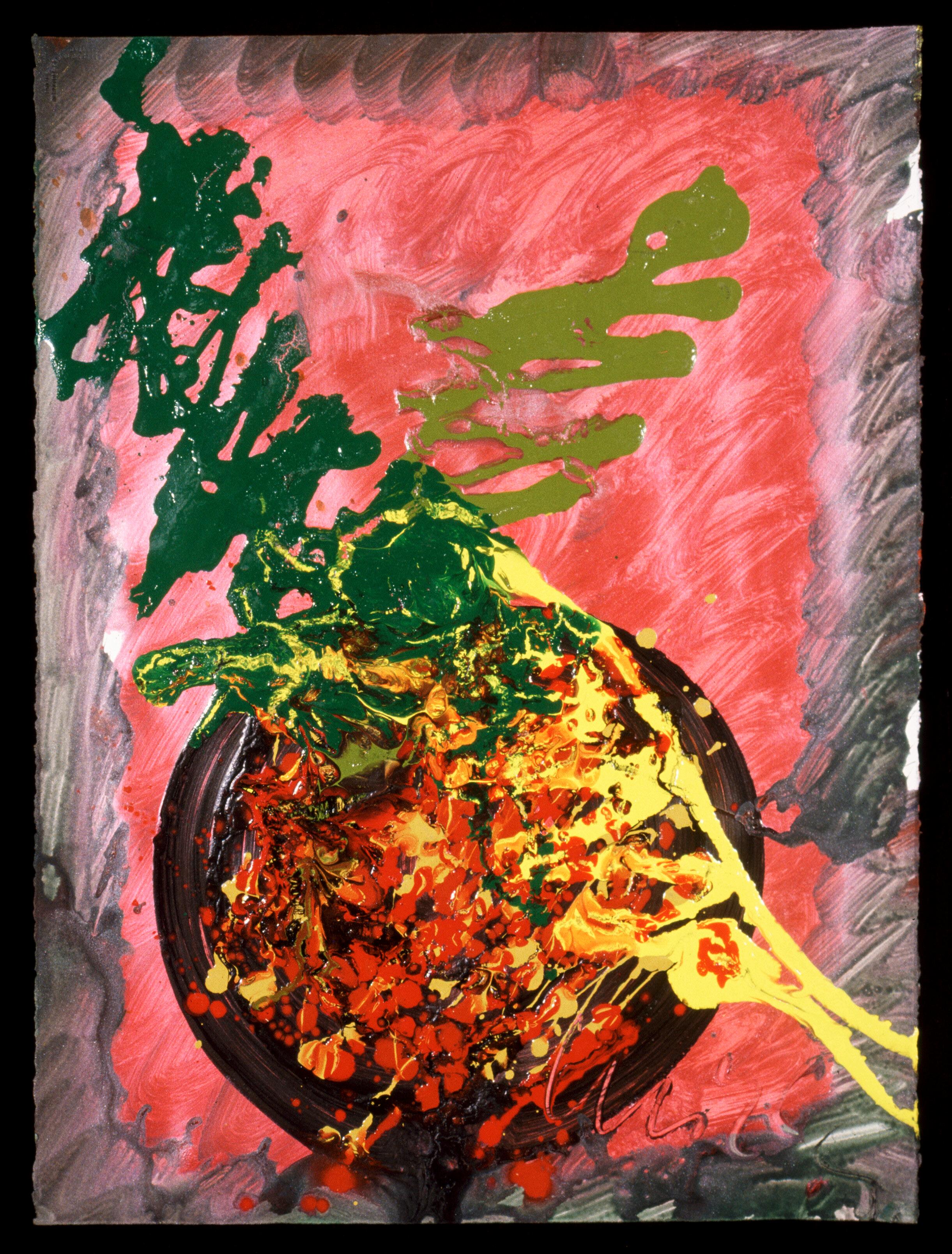
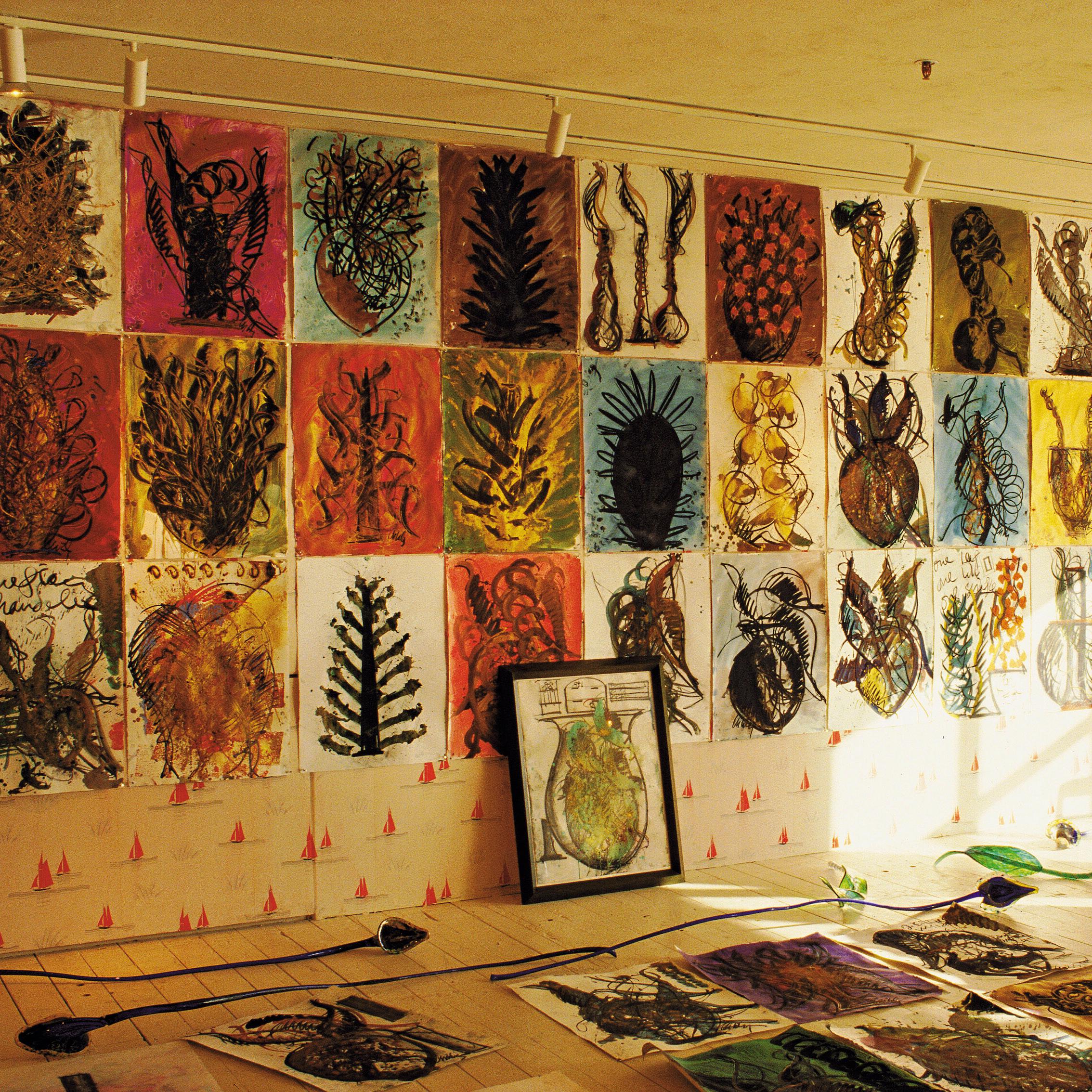
Born in 1941 in Tacoma, Washington, Dale Chihuly was introduced to glass while studying interior design at the University of Washington. After graduating in 1965, Chihuly enrolled in the first glass program in the country, at the University of Wisconsin. He continued his studies at the Rhode Island School of Design (RISD), where he later established the glass program and taught for more than a decade.
In 1968, after receiving a Fulbright Fellowship, he went to work at the Venini glass factory in Venice. There he observed the team approach to blowing glass, which is critical to the way he works today. In 1971, Chihuly co-founded Pilchuck Glass School in Washington State. With this international glass center, Chihuly has led the avant-garde in the development of glass as a fine art.
His work is included in more than 200 museum collections worldwide. He has been the recipient of many awards, including two fellowships from the National Endowment for the Arts and thirteen honorary doctorates.
The Boathouse, Seattle, 1990
Chihuly has created more than a dozen well-known series of works, among them, Cylinders and Baskets in the 1970s; Seaforms, Macchia, Persians, and Venetians in the 1980s; Niijima Floats and Chandeliers in the 1990s; Fiori, Glass on Glass, and Rotolo in the 2000s. He is also celebrated for large architectural installations. In 1986, he was honored with a solo exhibition, Dale Chihuly: Objets de Verre, at the Musée des Arts Décoratifs, Palais du Louvre, Paris. In 1995, he began Chihuly Over Venice, for which he created sculptures at glass factories in Finland, Ireland, and Mexico, then installed them over the canals and piazzas of Venice.
In 1999, Chihuly started an ambitious exhibition, Chihuly in the Light of Jerusalem; more than 1 million visitors attended the Tower of David Museum to view his installations. In 2001, the Victoria and Albert Museum in London curated the exhibit Chihuly at the V&A. Chihuly’s lifelong fascination or glasshouses has grown into a series of exhibitions within botanical settings. The Garden Cycle began in 2001 at the Garfield Park Conservatory in Chicago. Chihuly exhibited at the Royal Botanic Gardens, Kew, in London, in 2005 and 2019. Other major exhibition venues include the de Young Museum, San Francisco, in 2008; Museum of Fine Arts, Boston, in 2011; and Montreal Museum of Fine Arts, in 2013. Chihuly Garden and Glass, a long-term exhibition, opened in Seattle in 2012.
California College of Arts and Crafts, Oakland, 1989
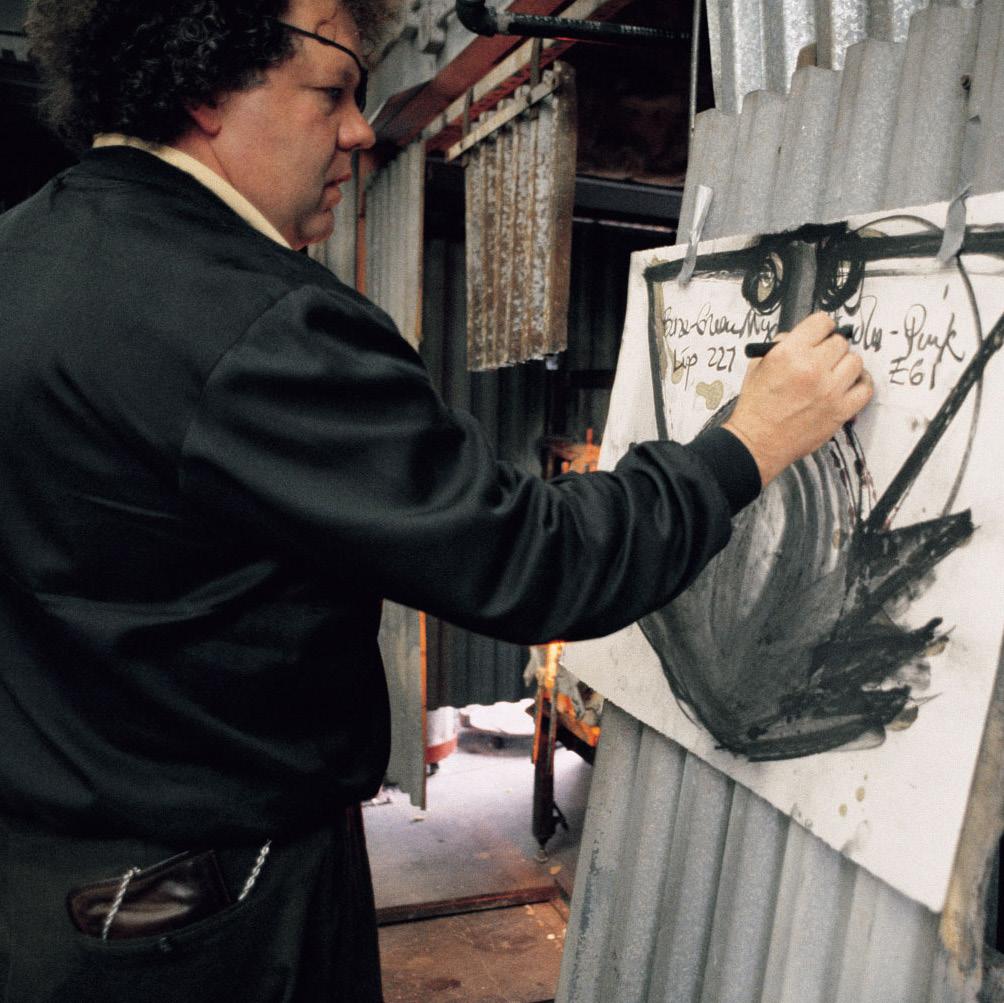
SPECIAL THANKS TO DALE, LESLIE AND THE ENTIRE CHIHULY TEAM
PHOTOGRAPHY:
Philip Amdal, David Emery, Claire Garoutte, Nick Gunderson, Scott Mitchell Leen, Terry Rishel, Mike Seidl, Chuck Taylor, Ray Charles White, Charlie Wilkins, and Nathaniel Willson.
CONTEMPORARY GLASS
DESIGN: Jeanne Koles
All artwork by Dale Chihuly © 2023, Chihuly Studio. All rights reserved.
© SCHANTZ GALLERIES, 2023 www.schantzgalleries.com